Want to know what it takes to start an ecommerce business from scratch and make your first $1,000 in profit in eight weeks?
In this weekly live case study I’m gonna show you every little step I take to achieve this goal. Including all the mistakes.
Visit this page each week to follow my journey:
%(tableofcontents)
Week #1: Finding A Product To Sell
What To Sell
Obviously, I needed a product I could sell in my Shopify store.
From my experience, there aren’t too many ways to come up with a product idea from scratch:
- Combining existing product/business ideas, or
- Creating a new product to solve a customer’s problem
For me, combining existing product ideas seemed way easier. If I’d combine two or more ideas and turn it into one new product the chances are higher that there’s demand for my product.
It’s similar to what Chief Sumo, Noah Kagan did when he had the idea of AppSumo. He took two markets (web apps + time-limited deals) and turned it into a new idea (time-limited deals on web apps).
My first step was to write down all the products I personally like.

What I did next was simple. I asked myself which products I bought the most in the last six months. I did this because I wanted to be my own target audience. This will hopefully help me later to understand my potential customers better and serve them in the best possible way.
Turned out that I bought eight pairs of Jordan/NikeID sneakers and four backpacks.
Now, as I had my two products, I wanted to understand why I purchased these products. Why on earth did I spend so much money on these products?
Jordan/Nike ID Sneakers:
For two reasons:
- To be part of the “Jordan movement” and be a cool kid.
- To customize my shoes and have my own name on it.
Backpacks:
I used to serve with the German paratroopers and we obviously had to carry a ton of things in our backpacks. Back then, I was always looking for a better backpack. Even though I don’t serve in the Army anymore, I kept this interest and still love to travel with a backpack.
In my opinion, it looks cool and is way more functional than a suitcase.
Putting it together, I instantly had a product idea: customizable and very functional backpacks.
Definitely a product I would buy.
Even though I was excited about this idea, I knew there was also a downside to it: the costs.
My goal was to be profitable as soon as possible. Unfortunately, customizable backpacks in a way Nike does it with their NikeID shoes can only be profitable with a well-established and optimized supply chain. So I had to adjust my idea accordingly.
The problem: custom backpacks are expensive.
The solution: custom rubber patches to put on the backpack.
Now I would sell the same backpack to everyone with the option to customize the rubber patch. This was at least some kind of uniqueness. If my business turns out to be a success, I could still improve and turn back to the initial idea.
Brand Name + Logo
I wanted to get my business started as fast as possible. Overthinking the whole process of finding a name and a logo would only cost me time.
I put all terms I could think of related to backpacks in a Google spreadsheet. I also played around with these terms to come up with my own versions of them.
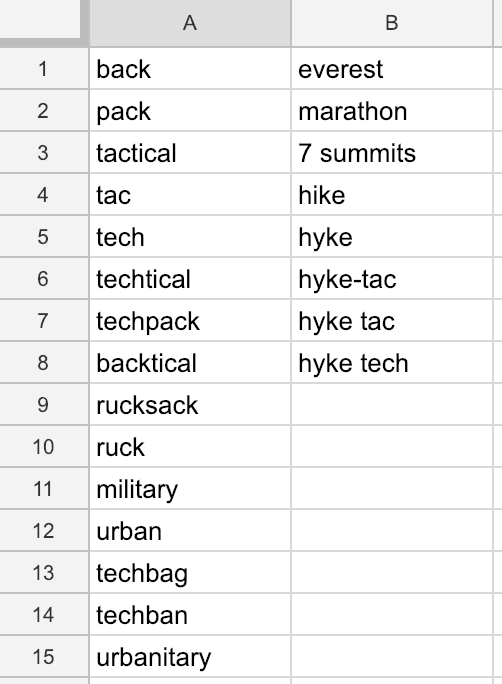
I liked “hyke”, my own version of “hike”, the most and so I choose to go with it.
Logo-wise I also wanted to keep it simple. As I’m not a designer and didn’t want to hire one for the logo, I choose to create a simple but good looking font logo.
I went to 1001fonts.com and searched for terms like “modern” and “science fiction”, because I wanted my logo to be simple and futuristic. This was a personal preference and had no specific reason.

Seconds later I had my logo ready to go.

Having the name and logo all set I was ready to work on my unique selling proposition (USP).
Unique Selling Proposition
What makes HYKE different? Why should a customer purchase from me instead of my competitors?
These are the questions I asked myself to find my unique selling proposition. I don’t just want to sell some backpacks. I want to have a unique approach.
My initial USP was to sell customizable backpacks. As this idea was too expensive to start with, I had to find a USP which is at least somehow related to my initial one.
The plan was to sell one type of backpack + customizable rubber patches but I expected to face a minimum order quantity when finding a supplier. That’s why I changed my idea again. The new plan was to use a color spray to customize each rubber patch.
If my color-spray idea works, I could also customize the backpacks by hand, something like Casey Neistat does with his suitcases.
That said, in the comments of the above YouTube video I found some kind of business validation:

There seems to be at least some demand.
Hand-painted customized backpacks with rubber patches.
Sound good to me. Simple to start, and after successful validation (aka making sales), I could easily improve by offering more rubber patch versions until I’m able to actually offer customizable backpacks alá NikeID.
So far, so good.
Now it was time to find a supplier who can help me build my business.
Product Sourcing
Finding a good and reliable supplier is crucial for any ecommerce business.
The first website I visited was, obviously, Alibaba.com. There’s no other website with that many suppliers. Personally, I’ve had good and bad experiences with suppliers from Alibaba in the past.
As the majority of my experiences were good, I wasn’t afraid to look for suppliers on it, even though some voices on the web are brutal when talking about Alibaba.
I simply looked up some terms like backpack, tactical backpack, military backpack, functional backpack, etc.
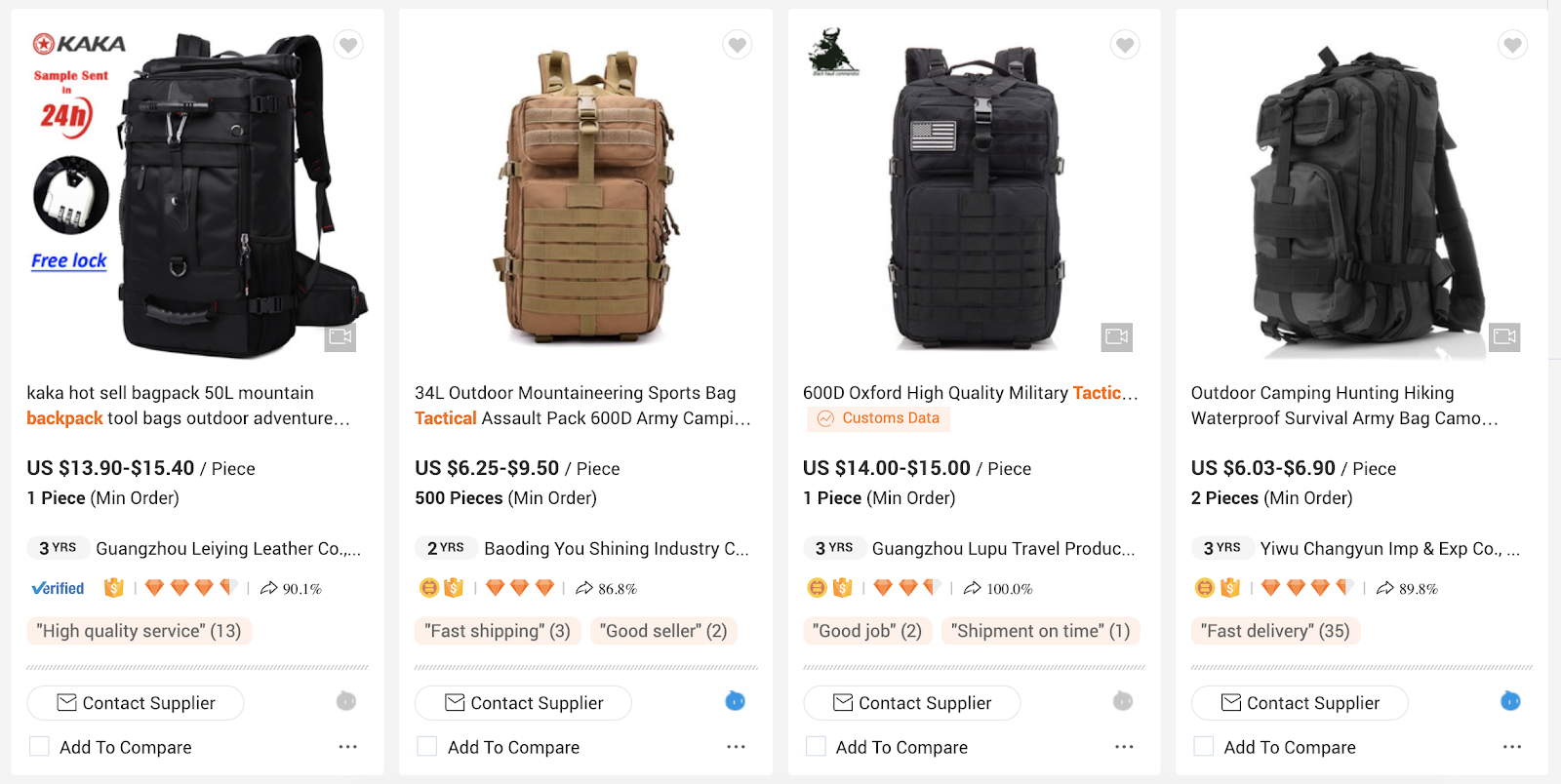
I had to look up hundreds of different backpacks to really find what I wanted.
My criteria for the perfect backpack was:
- Be available in black.
- Have space for a laptop.
- Have at least 40 liters of volume.
- Cost no more than $15 each.
- Have space for my logo + customization.
This was definitely not fun or exciting work.
It took me eight to ten hours of pure research until I had a selection of five backpacks that matched my needs.

I reached out to everyone and asked:
- How high their minimum order quantity (MOQ) is.
- How much each backpack is
- How much shipping to Germany (my location) is, and
- How much the rubber patches are.
When picking a supplier, not only the price plays a role. I want my supplier to reply within 24 hours (maximum). Unless it’s Chinese New Year or Sunday, I won’t consider a supplier as my future supplier if they don’t respond within that 24-hour timeframe. Communication is key.
That said, two out of the five suppliers didn’t even respond after 48 hours.
After quite some back and forth with the remaining three suppliers, I decided to go with the one who had the most experience and best rating. They also have outstanding customer service which is exactly what I was looking for.
As customer service isn’t everything, I wanted to test the quality of my supplier’s products. So it was time to order product samples.
Product Sample
To test the quality of the backpacks and the rubber patches, I chose to order two backpacks (different colors) and two rubber patches. Due to the high setup costs of the manufacturer, one rubber patch sample would cost $60. As 100 patches cost $80, I decided to order 100 for $20 more.
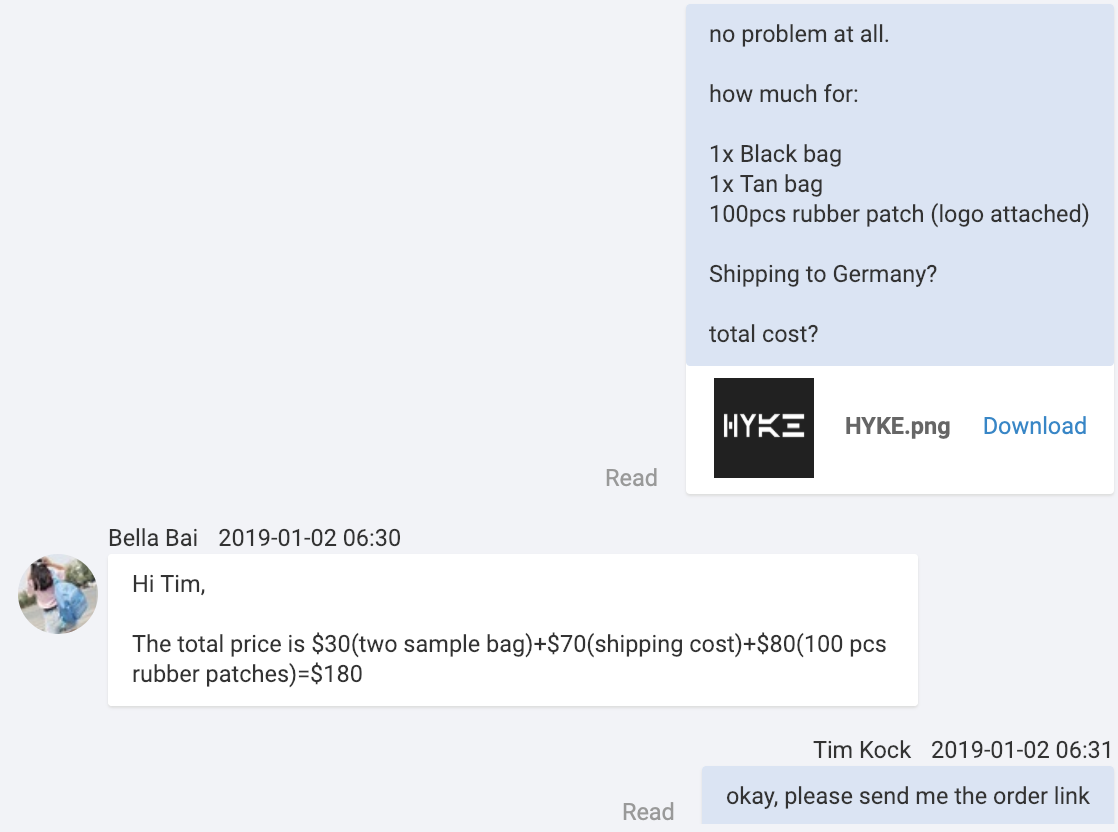
$180 including express delivery to Germany seemed solid and I placed my sample order.
A few days later, I received a package…
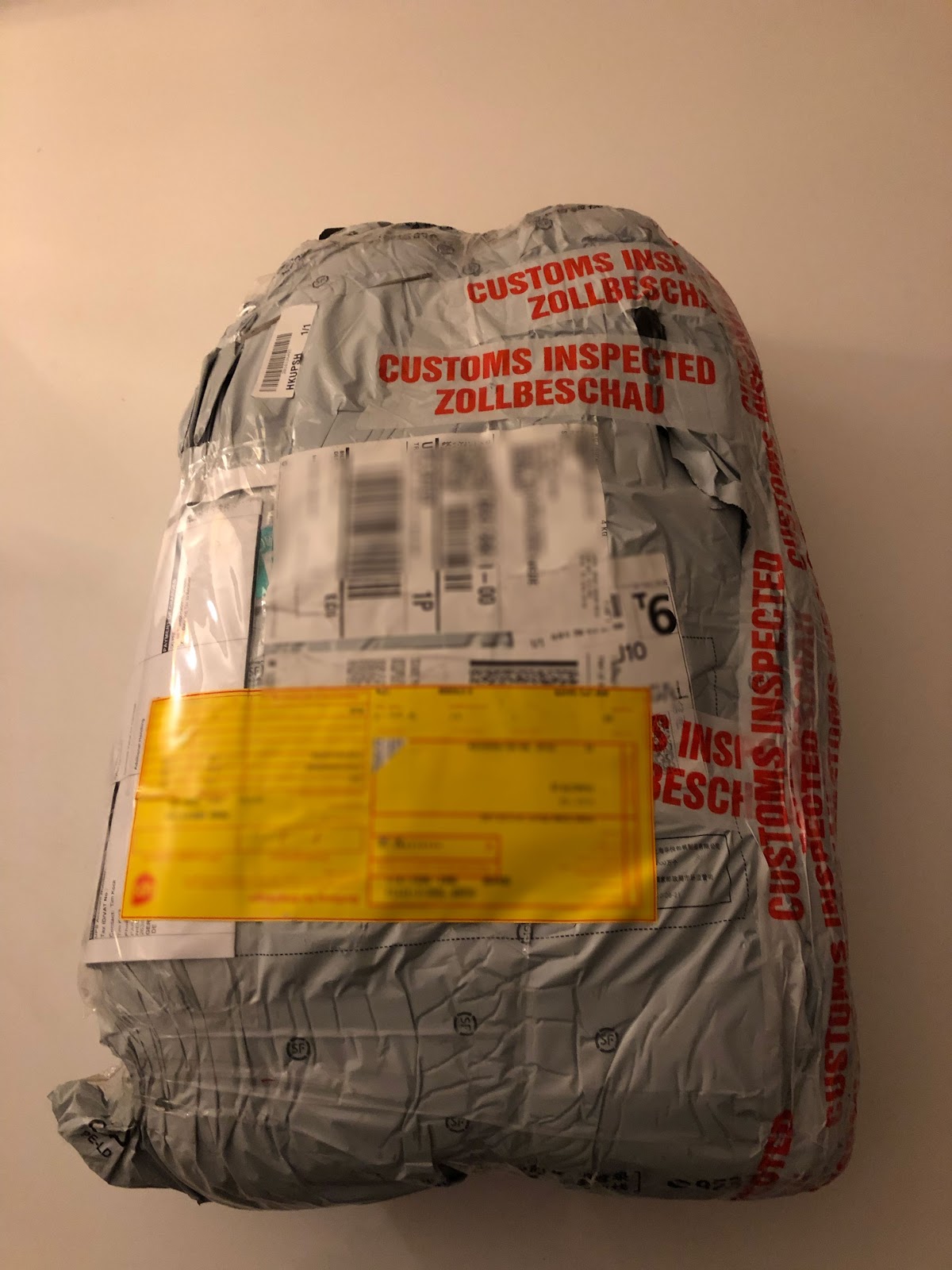
Week #2: Planning To Make $1,000 Profit
My girlfriend had a very hard time…
First, she had to deal with my, let’s say not-the-best-mood, in the days prior to my sample order delivery as German customs didn’t let the package go through. Second, when the package finally arrived, she had to deal with my over-excitement about it!
Express shipping from China to Germany only took three days. Unfortunately, my supplier tried to trick the German customs by saying the products are worth $7.00.
This would have saved me custom fees. But this has become very common practice, and German customs figured it out. So the delivery was put on hold until I could prove how much I actually paid.
Here’s the email I sent to UPS with screenshots of my $180 USD Alibaba transaction, which took care of customs:
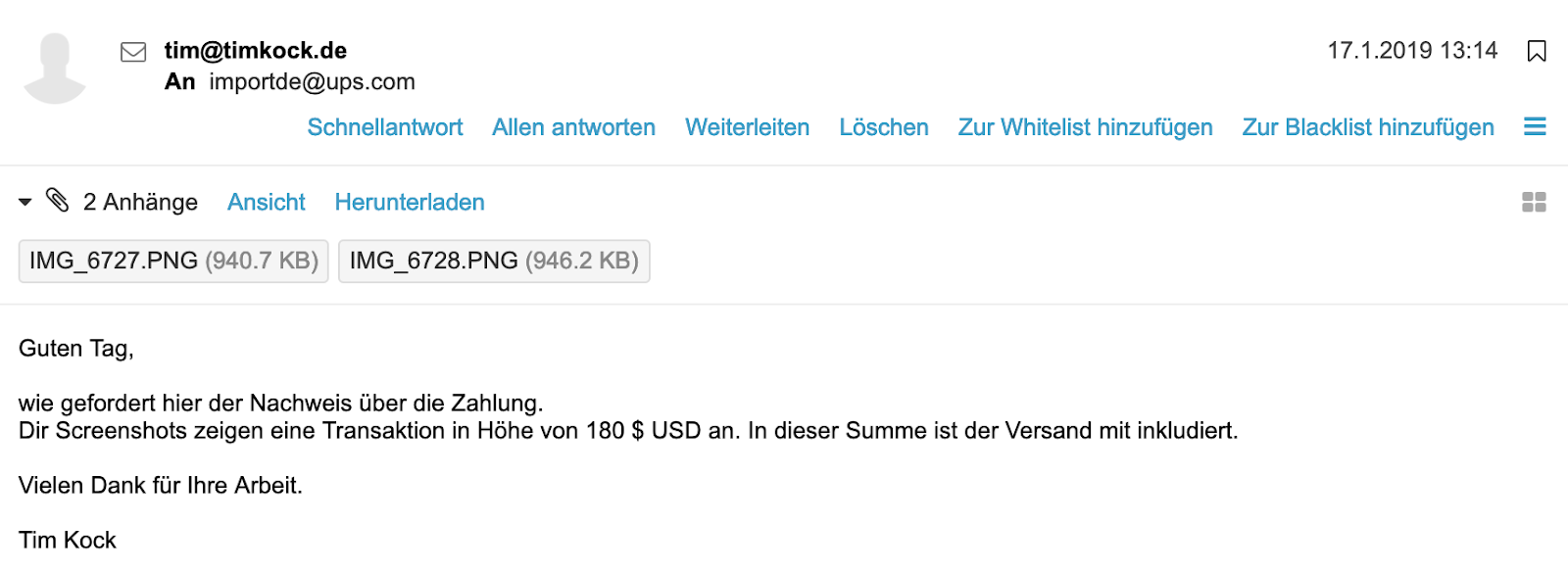
Translation:
“Hello,
as requested the proof of the payment.
The attached screenshots shows a transaction of $180 USD. Shipping included.
Thanks for your work.
Tim Kock”
Lesson learned: From now on I’ll make sure the invoice attached shows the actual amount when shipping overseas. I don’t care about customs fees — it’s part of the business, but I care about time. If I pay for express shipping I’d like to get my package fast.
The Sample Order
On the day my sample order arrived, I felt excited and nervous. A few questions kept running through my head:
- Are the products worth the investment?
- How’s the quality of the zippers?
- Will the backpacks smell like cheap products?
- How’s the quality of the rubber patches?
In the end, I was very satisfied with the product quality!
The backpack, zippers, and rubber patches are exactly what I was looking for! I didn’t expect that, to be honest.
The backpacks: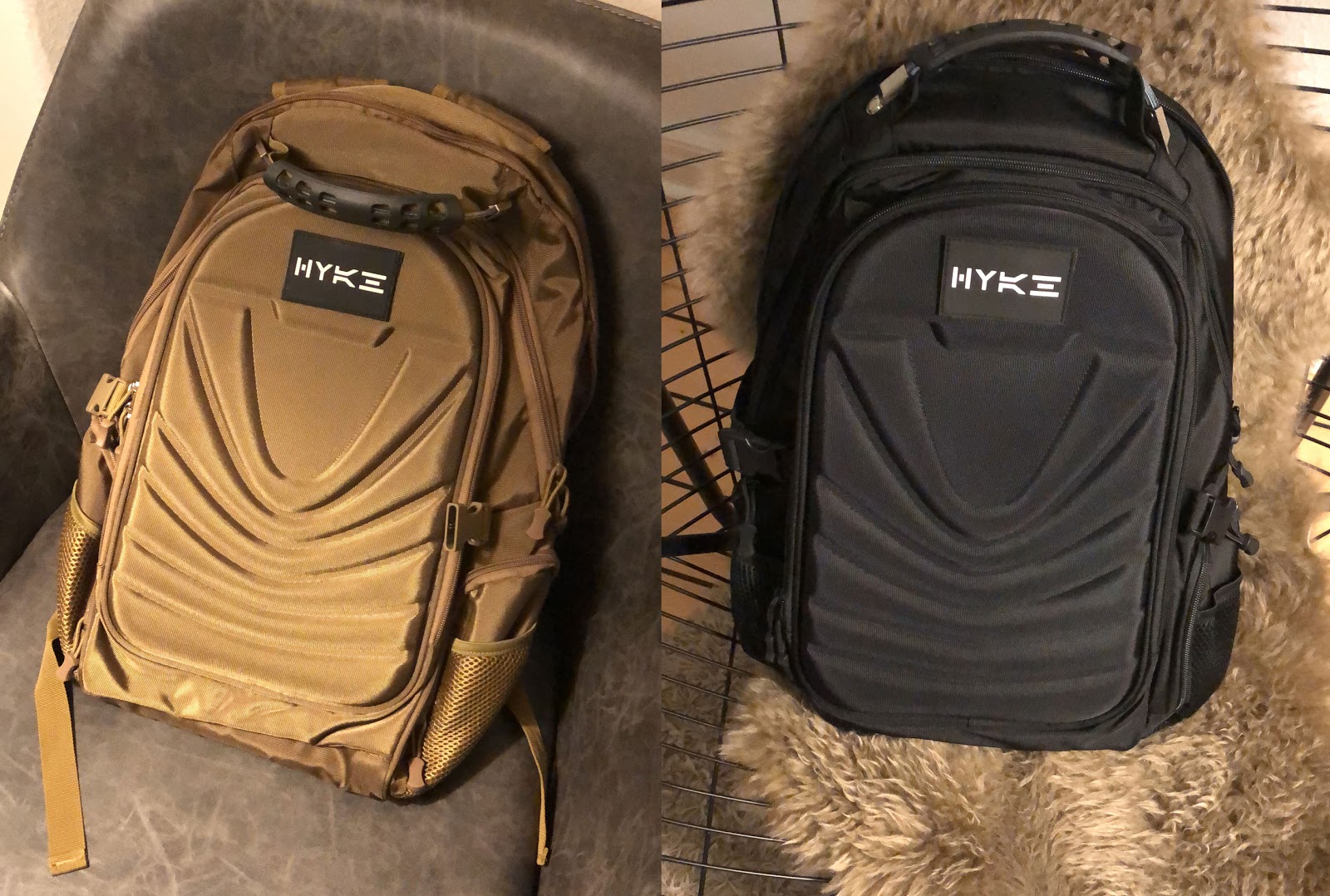
The rubber patches:
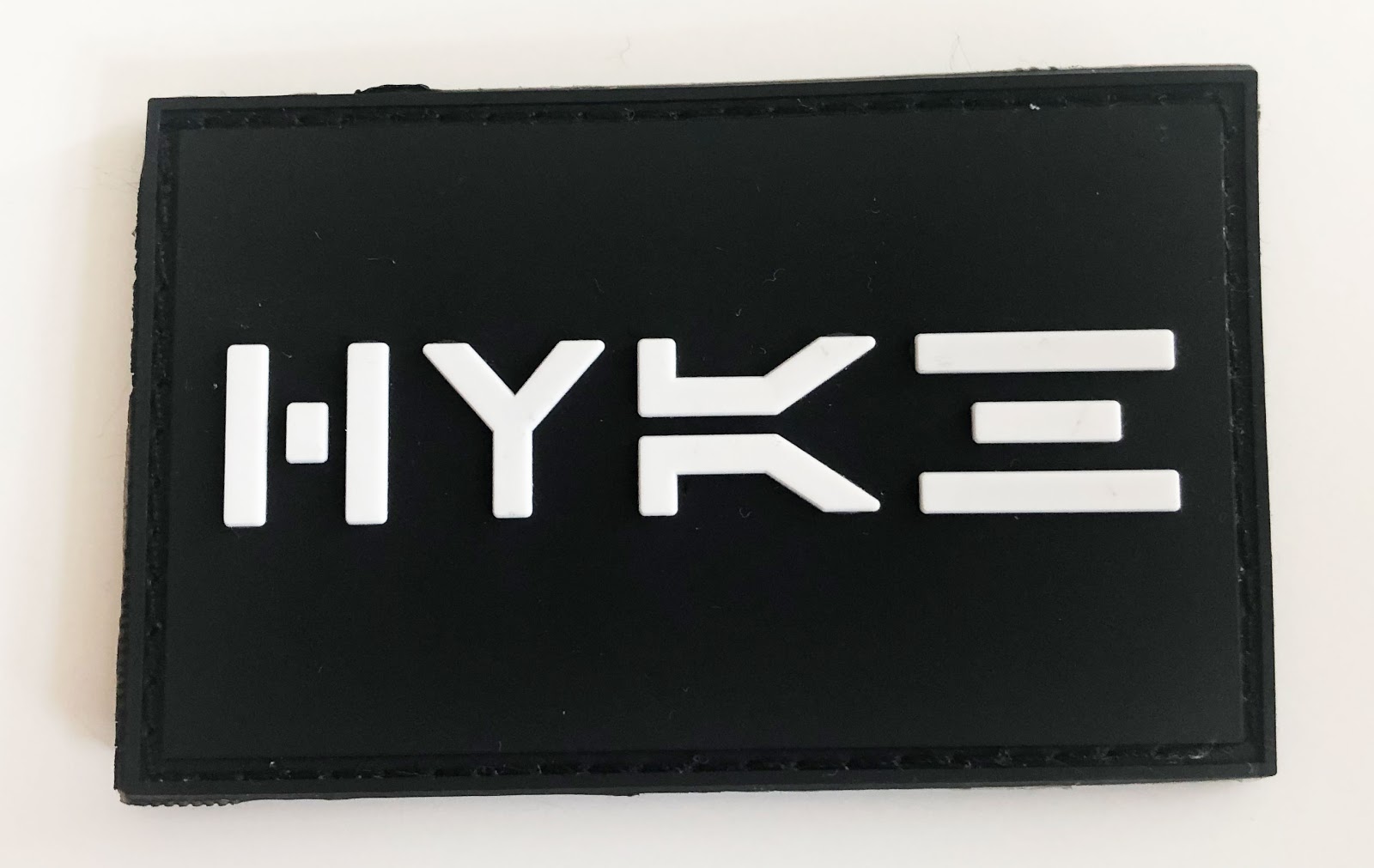
I felt very confident selling this product to my future customers.
However, to make sure I’m not blindly jumping into something, I wanted to have the feedback of friends and family. Usually, when asking people who love you about something like this they will say it’s awesome — no matter what it is.
I had to trick them. To some, I said I just bought this new backpack and to others, I said I won the backpack. I didn’t even ask directly what they think about the quality. I wanted to see their natural reaction. Luckily, all of them seemed to like the product. This gave me a small confidence boost that I could move on.
Due to a minimum order quantity of 100 pieces for each color (see screenshot from suppliers pricing below), I had to make a decision which color I wanted to start with. I had no data to rely on, so I went with black.

I assumed black would sell better, as black matches with every other color.
Being at the beginning stages of my new ecommerce business, I had to do some math.
The Math
My whole approach on this new business is “keep it simple.”
My calculations are no different.
At first, I wanted to know how much money I would need to get started.
The price of one backpack is $11.50. I asked for a discount and the supplier offered $11.30. Not that much, but as I wanted to order 100 backpacks, I’d save $20.

As you can see I said that I had to ask my boss about the price. I wanted them to feel like I’m just the guy who communicates, and not the one making the decisions in my company.
Back to the calculation:
$1,130.00 USD (100 backpacks)
+ $80.00 USD (100 rubber patches)
+ $970.00 USD (express air shipping to Germany)
+ $215.00 USD (approximate, customs)
= $2,395.00 USD*
*this sum doesn’t include taxes, as I will get them back with my tax return.
Of course, there will be more costs later on. But for now, this $2,395.00 is my startup cost.
Next up, I wanted to know how many backpacks I had to sell to break even. I put all the numbers into a Google spreadsheet and did two calculations. One for the case that a customer would order with a discount of 30% (column B pictured below), and another one without applying a discount (column D).
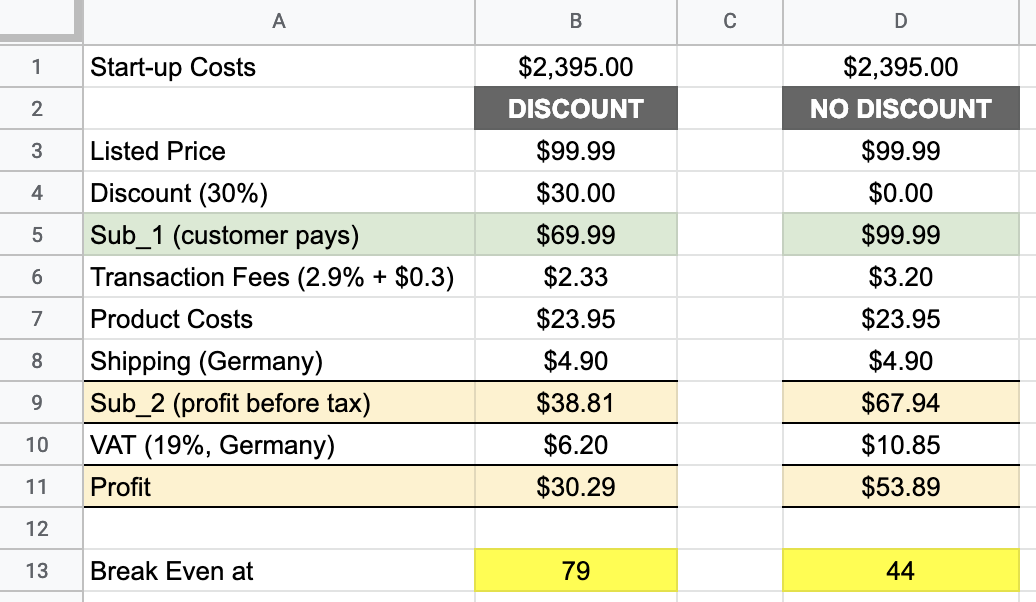
You can get a free copy of my spreadsheet here (click File > Make a copy to get your own copy).
Please note: I’m running this business out of Germany and tax calculations may be different to your country. Update tax rates to match your country.
If I sell my backpacks for $99.99 with a 30% discount, I’d need to sell 79 to break even (or 44 if selling without a discount). Not bad.
I picked $99.99 for the retail price because I can. I’m the one who sets the price and I’d rather start with a slightly premium price. I could still lower the price later. As $99.99 didn’t sound too expensive for a custom/hand painted backpack, I moved on.
Even though I was confident those numbers could work, I was anxious that I’d burn more than $2,000. But I placed my order at Alibaba anyway.

To get away from those bad thoughts, I kept myself busy with setting a very concrete goal for my new business.
Setting A Business Goal
A few years ago, when I started my entrepreneurial journey, I jumped from one goal to another. I had 20-30 goals at once. Unfortunately, I didn’t achieve any of them.
Now, with some experience, it’s more obvious to me why I had no chance at all back then. I was too distracted and didn’t focus on anything.
Maybe it’s just me, but I only achieve my goals if I set them very clearly. In the best case, one goal at a time. When Sumo doubled blog traffic from 100,000 to 200,000 website visitors in one month, they only had one goal – blog traffic.
With that said, I needed a specific goal for my new business.
A very common practice is to set a S.M.A.R.T. goal. Each letter has its own meaning:
S. – Specific
M. – Measurable
A. – Attractive
R. – Realistic
T. – Time-bound
Let’s break ‘em down!
Specific:
A bad example is: “make as much money as possible”. This is far away from being specific. My “S” is: “I want to make $1,000 in profit”.
Measurable:
Again, “make as much money as possible” is a very bad example. You can’t measure this. How will you know when you have achieved your goal? As my “S” is “I want to make $1,000 in profit” it’s very easy for me to measure the amount of money I make.
Attractive:
A goal has to be attractive to you. Not your neighbor, your wife, your husband, etc. My goal to make $1,000 in profit won’t lead anyone to wealth but that’s not the point. For me, it’s more than attractive as the product I’m about to sell is something I personally love. It’s the combination of two products I use every single day (and it’s even my own brand).
Additionally, that $1,000 is the validation I need to move on and spend more time and money on this business.
Realistic:
I know, I know… I also see those “set a goal you’re afraid to think about” quotes on Instagram. However, the goal I’m setting here isn’t my life goal. It’s a short-term goal.
Making $1,000 in profit would mean I have to sell 63 backpacks (113 if giving a 30% discount). I didn’t see any problems with achieving this.
Time-bound:
Setting a goal without setting a deadline is just playing around. This point is directly connected to the point of setting a realistic goal.
If I’d set the deadline to 10 years, $1,000 wouldn’t be that impressive, right? I had to make sure the time I have to achieve this goal is long enough to be realistic but still require some work. Considering I run my own businesses, eight weeks seemed good for this new ecommerce project.
In the end, I came up with this S.M.A.R.T. goal:
I want to start a new ecommerce business from scratch and make $1,000 in profit in eight weeks.
Everything looked good so far. However, the greatest goal is worth nothing if there’s no one interested in the product I sell. That’s why I wanted to figure out who my target audience could be.
Target Audience
As the product idea itself is based on my own personal preferences and interests, it’s easy for me to define a person who could be interested in my product: me.
Even though “29 years young, male, handsome” hits the nail right on the head, I wanted to dig deeper and describe my audience in detail.
I didn’t want to only include demographic data, but also consumer behavior and a glimpse of a day in my life.
I created my “perfect customer”:
Demographic data
| Gender | Male |
| Age | 29 |
| Income | $100,000+ |
| Professional Qualifications | Bachelor Professional of Business |
| Occupation | Entrepreneur, Freelancer |
Consumer behavior data
| Rational buying decisions… | Car, Groceries, Business Expenses, Furniture |
| Irrational buying decisions… | Sneaker, Apple, Books, Gifts, Business Class Flights, Whiskey |
| Retargeting that works on me… | Software, Complementary Apple Products |
| Marketing that never works on me… | Online Courses, E-Books, “Instagram brands”, Free+Shipping |
A day in my life
| Wake up at | 5:00 am |
| First thing in the morning | Drink coffee / try to meditate (2 out of 5 days) with the headspace app |
| On the phone for the first time at | 5:30 – 6:00 am |
| On the computer for the first time at | 6:00 am |
| First thing(s) on the phone | Emails, Shopify, Instagram, Assistant’s messages |
| First thing(s) on the computer | Facebook, Messenger |
| Times in touch with ads | 3-5 (assumed) |
| Where in touch with ads | Facebook, Instagram, Newsletter |
| Ads which work (or could work in future) | Instagram, Newsletter |
| Preferred marketing | Content (blog, video) |
| Weirdest thing on a daily base | Meditating, journaling |
| Hours per day working | 8-16 |
| Time spend after work | Girlfriend, Netflix, Reading, Video games |
| Biggest struggle on a daily basis | Find more time for family/friends |
Those lists give me a very good overview of whom I’m about to target.
Maybe there will be female employees with two kids that hate Apple who will purchase my backpack — who knows. But that’s not even the point here.
Creating this list and figuring out who could be my perfect customer gives me a good idea of how to start and where to promote my products. It makes the business more real and reminds me that I’m selling to a human being.
Let’s do a short recap:
Within about 12 days I came up with a:
- Product idea.
- Cool name + logo.
- Reliable supplier.
- Sample order delivered to my home.
- Profit calculations.
- Proper business goal.
- Good idea of who my target audience is.
Not bad.
The whole thing became more and more real, so I wanted to take the next step: product photography.
Product Photography
My future customers want to see the product I’m selling. So there’s no way around product images for my online store. Of course, I could have asked my supplier from Alibaba if I’m allowed to use their images. But as they don’t have my logo attached and the quality of their pictures are not that good (see image below), I wanted to have my own shots.

The problem, I neither have a DSLR camera, nor do I have access to a photo studio. Meh.
But that’s startup life; solving problems. The solution to this problem was simple. I had to find someone in my little town of Wilhelmshaven, Germany who has the things I need. I didn’t want to hire a professional photographer as the results wouldn’t be that different compared to a good amateur, but the price would be way more expensive.
I looked up the hashtag #wilhelmshaven on Instagram in the hope to find a good hobby photographer.
I also did Google searches for several terms (eg. “Wilhelmshaven hobby Fotograf”, “Wilhelmshaven Fotostudio mieten”, “Wilhelmshaven Startup”). I did this to find people who would have access to the things I need:
- DSLR camera
- Access to a photo studio

Doing the “wilhelmshaven startup” Google search I discovered a sneaker startup — based in my hometown!
I called them and we arranged a meeting the next day.
The founder, a smart 26-year-old dude, and I were on the same wavelength from the first second. We talked a bit about what his label does (hand-painted premium sneakers) and what I do. Long story short: I did get access to their camera equipment and a small photo studio in exchange for marketing consulting. Win-win.
We took my sample backpack and shot a couple of shots for my online store (see the founder, Melvin Lamberty, taking shots below).
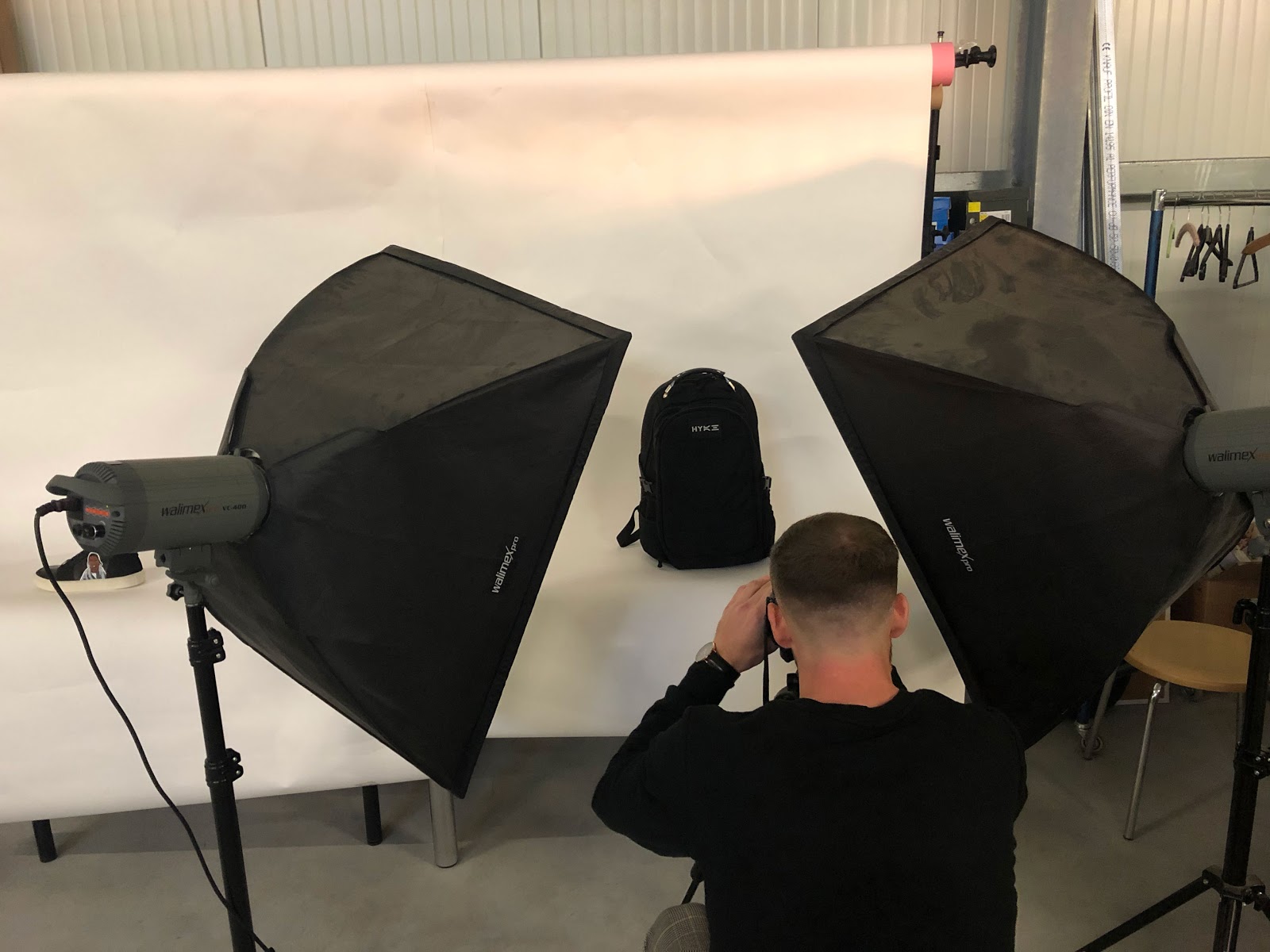
Here’s a close-up:
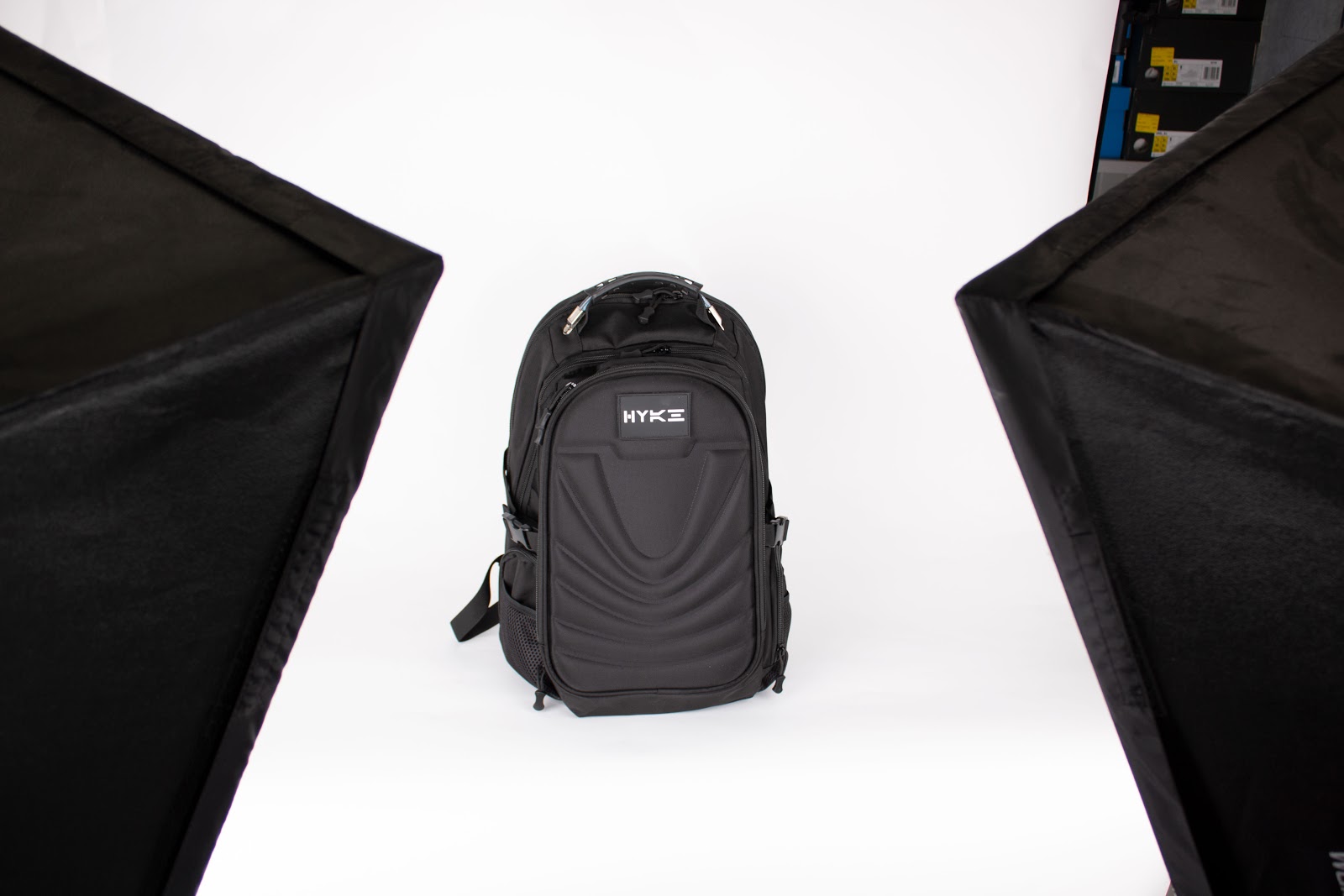
I left the studio with a bunch of high-resolution images of my backpack from a lot of different angles and a new, very valuable business contact — more on that later.
The lesson here is you don’t need to do everything on your own. A lot of things can be outsourced — your job, as an entrepreneur, is sometimes to find the right people.
That exact lesson also helped me find another contact: a 3D-artist.
Week #3: Prototyping, Packaging And Promotion Planning
Imagine the smell of gasoline.
Now imagine the smell if you’re in a pool full of gasoline.
Well… that’s how I felt.
Creating A Prototype
As you know from the previous parts of this live case study, I don’t just want to sell backpacks. I want to sell hand painted, more precisely hand sprayed, backpacks.
In order to figure out which color-spray works the best for my products, I had to do a spray test on the backpacks. And that was when the headache started (literally).
I planned to do the test in my garden, but unfortunately it was a rainy day and I didn’t want to wait. So I chose to do the test in my basement. Let me tell you, kids, this was a stupid idea. Don’t do this.
I tested for five criteria:
- Where to place the hand sprayed letters.
- How the color looks on black.
- How long it will take to dry.
- How the color smells after it's dry.
- How water-resistant the color is.
I bought two different types of color sprays, printed and cut out the lettering “HYKE” and did the test.
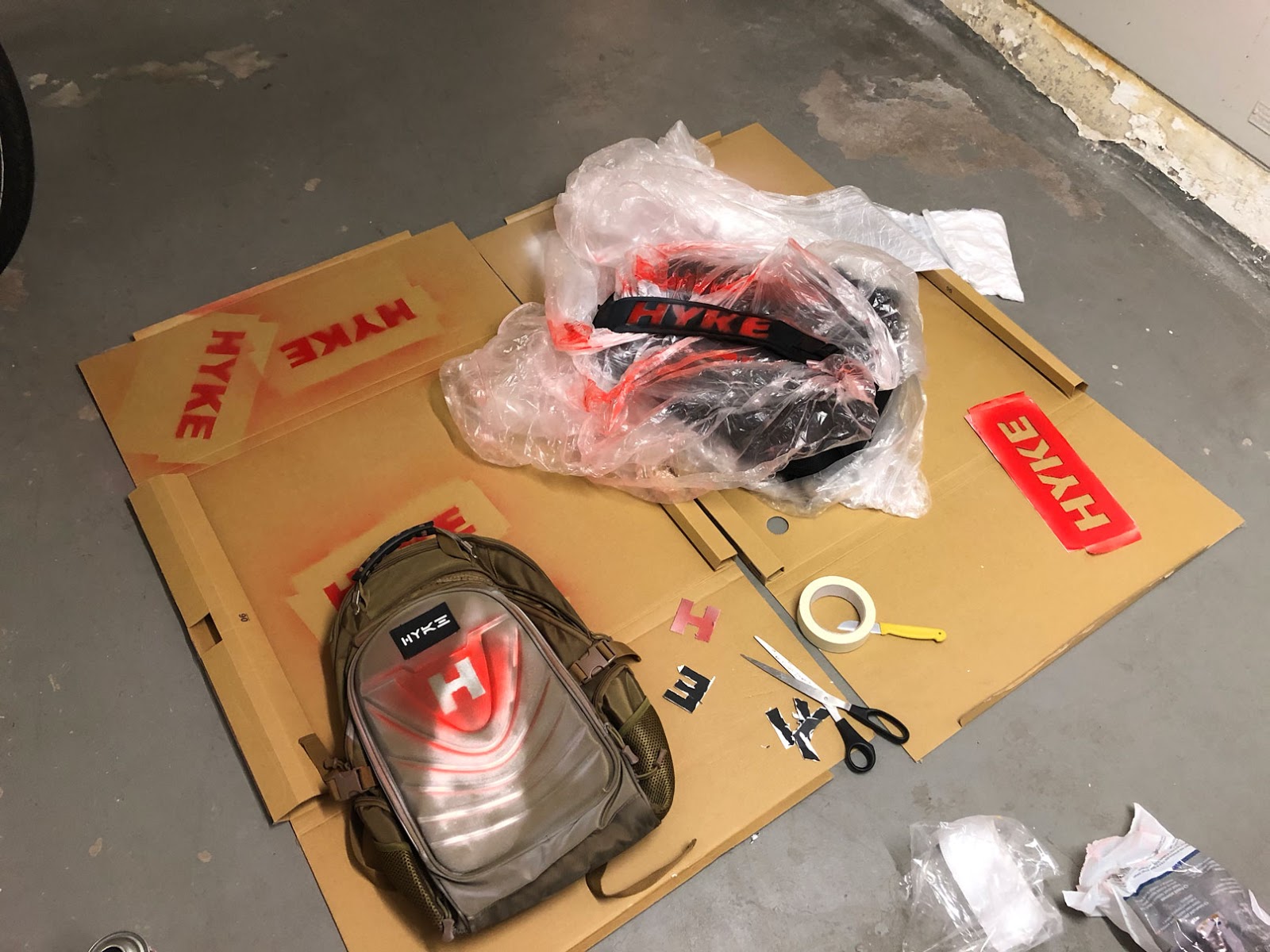
It looked like a mess and it’s far away from the final backpack, but it was worth it.
For example, my initial plan to spray the letters on the back of the backpack didn’t work out that well, so I decided to spray on the straps. Worked way better. Also, one spray wasn’t water-resistant, even though the can said it was.
At the end of the test I had a solid result and a good idea on how to actually create the product for my future customers.
In addition to the test on the backpack, I did another one. This time for packaging.
Finding The Right Packaging
Obviously, I will need to ship the products later on in this business. Therefore, I needed cardboard packaging and some tape.
Before jumping into a bulk order of 100 packages I bought one box at a local post office to try their standard sizes.
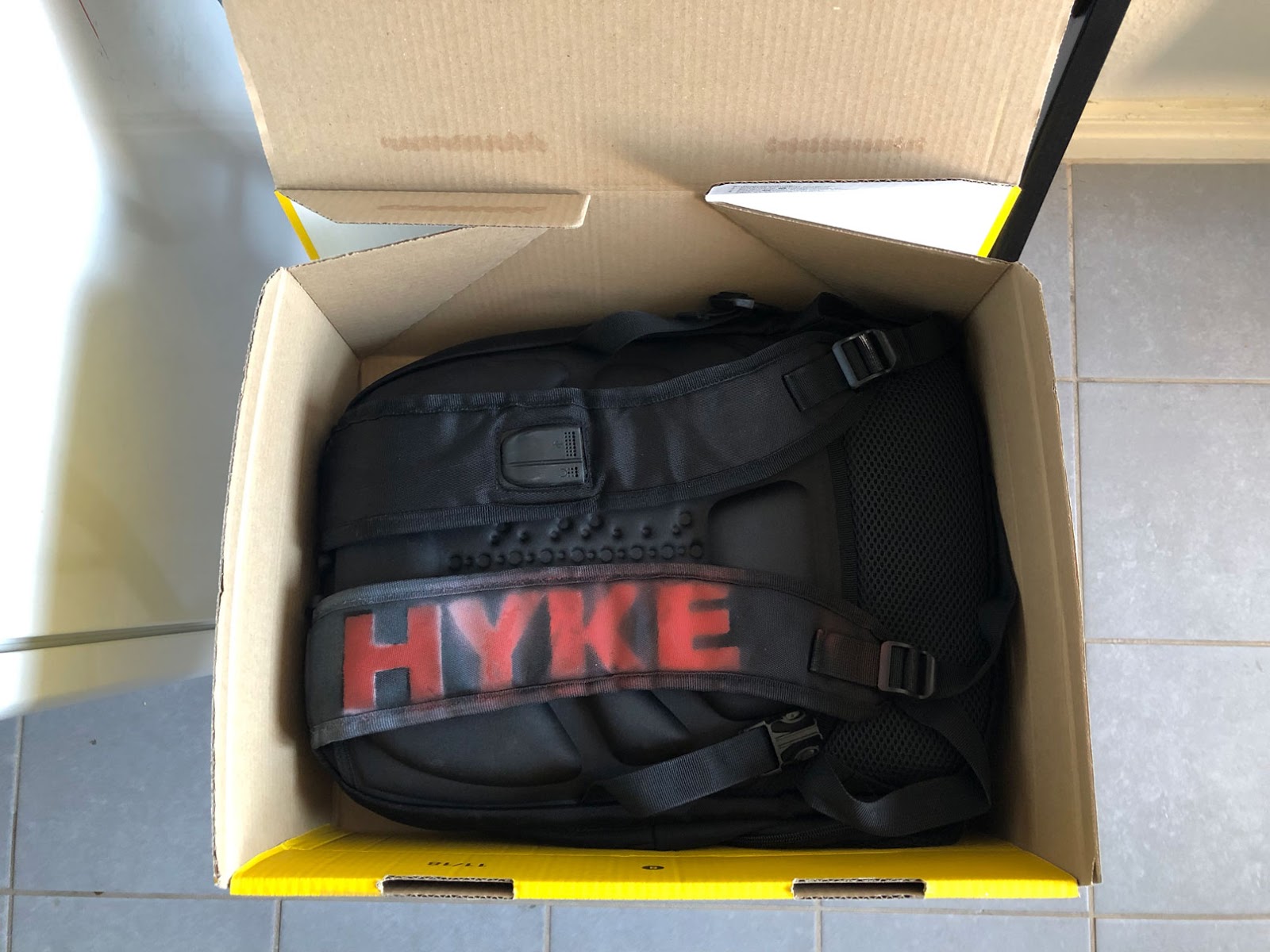
As buying these cardboard packages and tape one by one at a local post office is quite expensive (€2.49/each = $2.82 USD), I did a quick Google search to find a good and affordable supplier.

(English translation: Packaging material)
Didn’t take too much time, after around 10 minutes I found a good one. 75 packages for €35.25* (around $40 USD or $0.53/each) seemed like a good deal to me compared to the local post office price ($2.82/each).

One of the main aspects of my new business is the individual style, and that each backpack is unique. That said, I wanted to have the label “HYKE” on my packages so the customer instantly knows who sent this package.
Buying custom packages is very expensive, even custom tape is expensive. So I thought why not do it on my own?
I sprayed the letters on the package and et voilá:

But that’s not enough on the packaging!
I also wanted to have a dust bag for the backpack. For the little budget of this project, the unbox-experience should be as best as possible. As I’m about to charge $99.99 for my product, my customers should be satisfied.
Unfortunately, the research of dust bags which can keep up with quality and the size of my backpacks (49cm x 38cm) is still an ongoing process. I just haven’t found a good supplier (yet).
Overall, packaging is on track to be great!
Actually, everything seems to be going great so far. I haven’t faced any big complications yet.
Same for all the work I did together with other people. First the founder of a sneaker startup in my hometown, now the work of a 3D-artist.
3D Animation Of My Logo
When I saw my logo for the very first time I knew it would look good in 3D and couldn’t imagine it being a big deal to create in 3D. As I personally have no 3D software on my computer and didn’t want to spend any time learning new software, I asked a friend of mine if he could help out. Luckily, he did.
I sat down with him, told him what I wanted to have and he created a 3D logo animation of my logo for me. For just €80 (around $90 USD) I got a nice looking animation.
The reason I wanted to have this animation was simple: I want to have visual support for my marketing.
Planning My Marketing
So far I haven’t done any marketing. All I did was build the foundation for my new business. But as things are getting more and more serious it’s time for me to think about a few marketing approaches.
All of my marketing efforts should be aligned with my SMART goal ($1,000 USD in profit in 8 weeks). In fact, I worked backward from this goal to break it down into more actionable steps.
The first step I wanted to take was to figure out how much traffic I’d actually need to achieve my goal. Based on the latest Monetate Ecommerce Quarterly Benchmark Report, which shows an average ecommerce conversion rate of 3%, I did some calculations.[*]
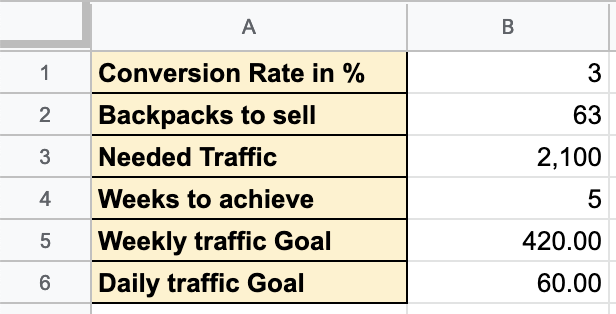
Remember my break-even calculation? I need to sell 44 backpacks at full price (or 79 with a 30% discount). But as the goal is not just to be break even but to make $1,000 in profit, I need to sell some extra product.
With a profit of $53.89 per backpack, I’d need to sell 19 more, making it 63 in total. This means I have to bring 2,100 people to my website.
Furthermore, as I planned to do marketing for my store for just 5 weeks*, my daily traffic goal was set to 60 visitors.
*Just 5 weeks out of this 8-week live case-study project. As long as the business exists, I will continue my marketing efforts.
Those numbers seemed more than achievable.
The next step was to figure out where to get the traffic from. I created another Google spreadsheet and put in all traffic sources and potential traffic I could think of for this new business.
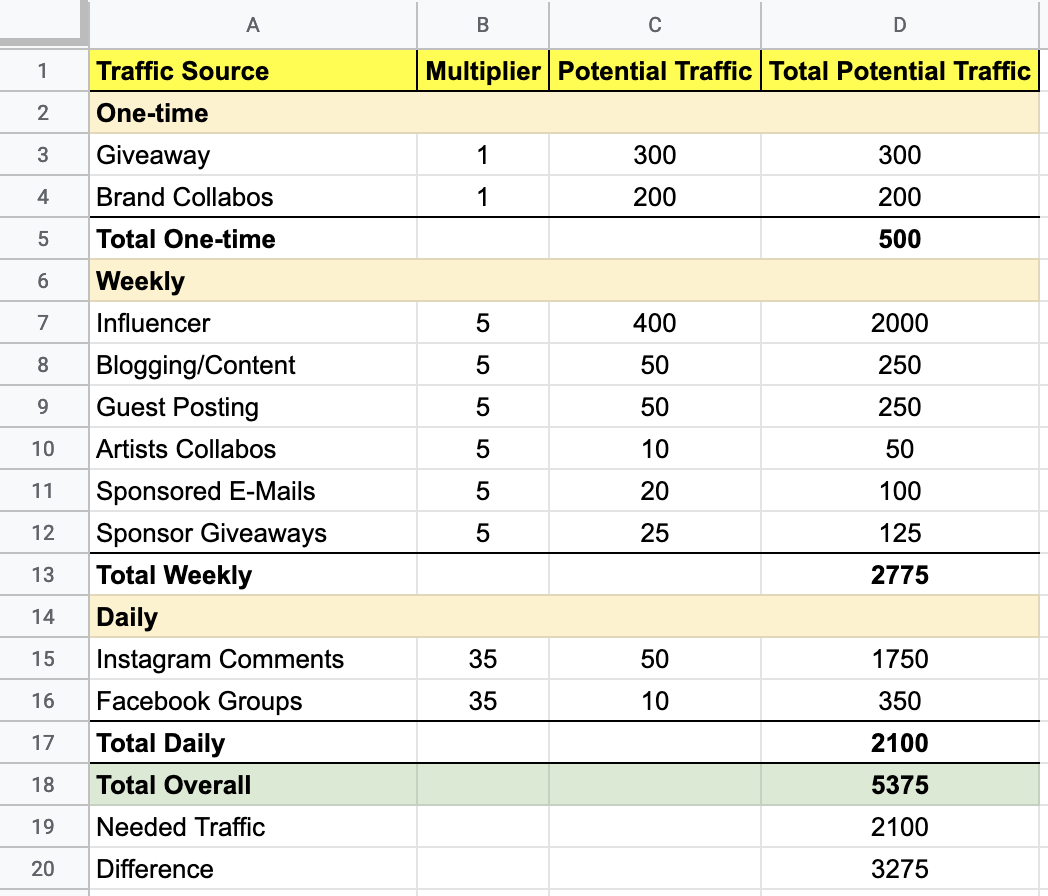
I split the sources into…
- One-time actions.
- Weekly actions.
- Daily actions.
As you can see on the image above, my potential traffic from all sources is 5,375. That’s more than 2.5 times the needed traffic. I was very happy to see this. Especially, as I tried to keep the traffic numbers as pessimistic as possible.
Even if the conversion rate will drop, too many people purchase with a discount or anything else happens that does not match with my calculations, I still have a good chance to achieve my goal.
But this spreadsheet is not only for traffic calculations. It’s also my marketing to-do list. I know exactly which things I have to do to achieve my goal. If I get busy and need to focus on just one marketing activity, I know which will bring the most traffic.
Overall, the numbers looked good to me and I felt ready to get started with my marketing!
But where do I send the traffic? I don’t even have a website, yet.
That’s why it was time to finally build my Shopify store!
Week #4: Setting Up For Marketing Success
Slowly but surely I felt a bit nervous.
10 days after the purchase of my backpacks the products haven’t even shipped.
Furthermore, the tracking code which was provided by the supplier seems to be wrong.

Honestly, the only reason I still felt okay about it, was the fact that my supplier still replied instantly and seemed to be worried, too.
But this long shipping process slows my business down and, unfortunately, destroys my five week marketing plan. I’ve now been working for four weeks on this business, and I’m not even close to starting marketing.
Even worse: as the whole idea of HYKE is selling hand sprayed backpacks, I have to show this to my potential customers. Right now I only have product images of the original ones. The test backpacks are far away from being good enough to make images with.
Long story short: I can’t promote my business in any way because I can’t show people what the product looks like.
This means one thing: once the products arrive, I will work even harder.
To be prepared, I asked myself: “what would you do if you only had two weeks of marketing?”
The first thing that popped into my head was: Adjust the traffic sheet accordingly. So that’s what I did.
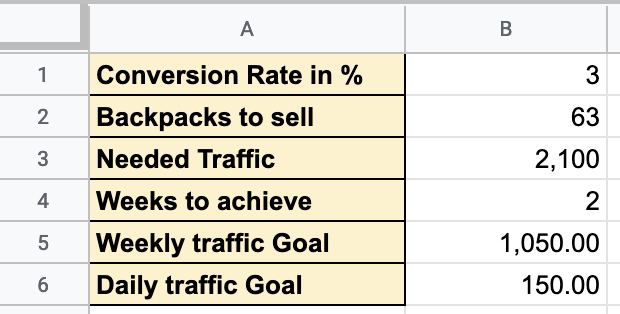
If all the numbers would stay the same, the amount of traffic I had to bring in almost tripled (from 60/day over five weeks, to 150/day over two weeks).
However, 150 visitors per day are still doable. To have a better idea of where to get my traffic from, I also adjusted my traffic source sheet. I felt that Instagram comments are the most practical thing to do, so I made a major change there: from 50 to 75.
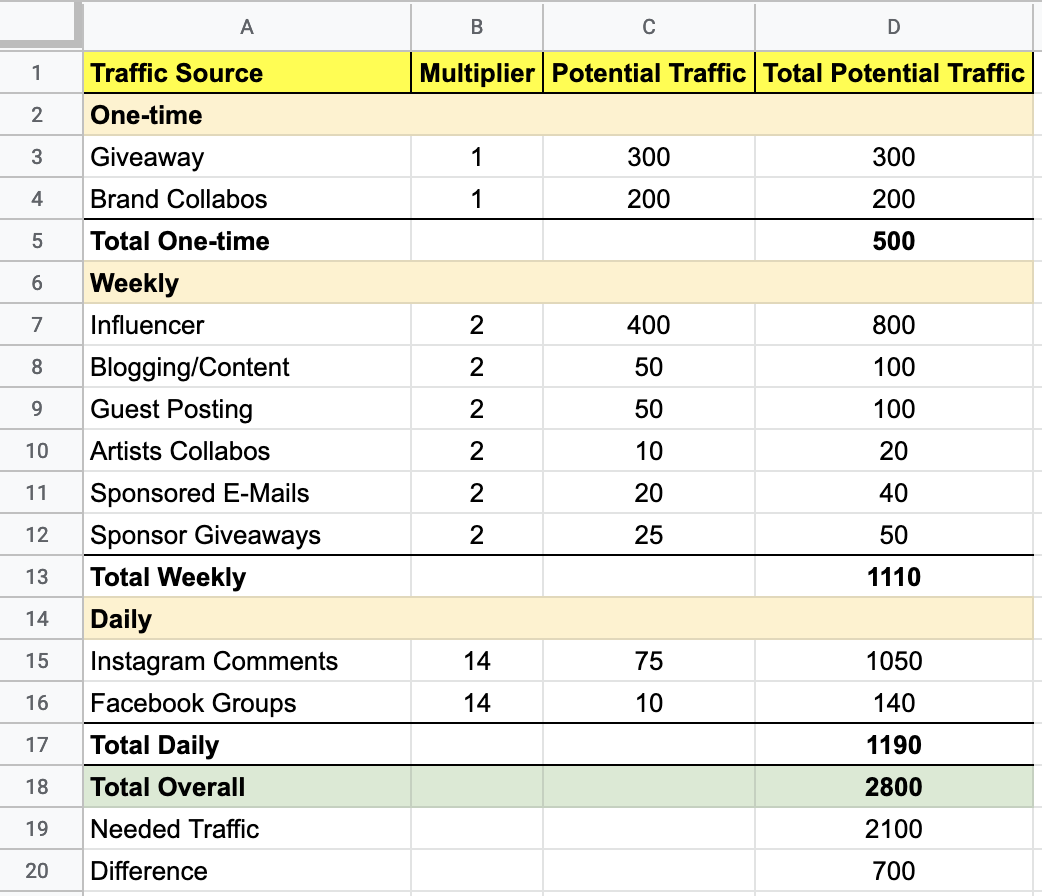
In fact, I’d only need to leave 25 more comments on Instagram every day (from 50 to 75 comments a day).
Remember, those numbers are just my worst-case-scenario numbers. By doing this I stopped being nervous about the shipping delay and actually felt happy because of it. Because this doesn't only mean it can still work out, but also means the result could be way better if the products arrive early.
Learning: Things happen in business. If you can’t control them directly, find ways to:
- Control your thoughts, and
- How to control something about it (even if it’s indirectly).
My initial plan was to open my online store this week so I can start selling the backpacks. Due to the delay, I had to change this plan. Just sitting around and waiting isn’t my style, so I started building an email list.
Building My Email List
In order to collect email addresses, I needed a website.
Even though I didn’t start to sell, I signed up for Shopify anyway. For now, only for the purpose of building an email list.
Usually, people don’t give out their email addresses easily. This is why I had to give them something in return.
As I already narrowed down my target audience in week two, I knew what kind of marketing works the best: content.
I choose to go with content for one reason: content marketing works the best on me. The whole business idea and my target audience avatar was completely based on my personal preferences. To keep the marketing align with it, I decided against other marketing tactics for now.
I also knew which topics I have to cover:
- Marketing
- Meditating/Journaling
- Cheap Business Class Flights
- Book Recommendations
- Whiskey Recommendations
- Time Management
The topics of my content marketing should be at least somehow related to backpacks, so I’m sending targeted traffic to my site who are more likely to buy.
As I couldn’t find any topic which made sense, I chose to go with the general topic of entrepreneurship put under the headline of the popular kids game “I packed my bag”. This could also become a cool email series.
To collect emails I installed the Sumo app for Shopify and set up a Welcome Mat.
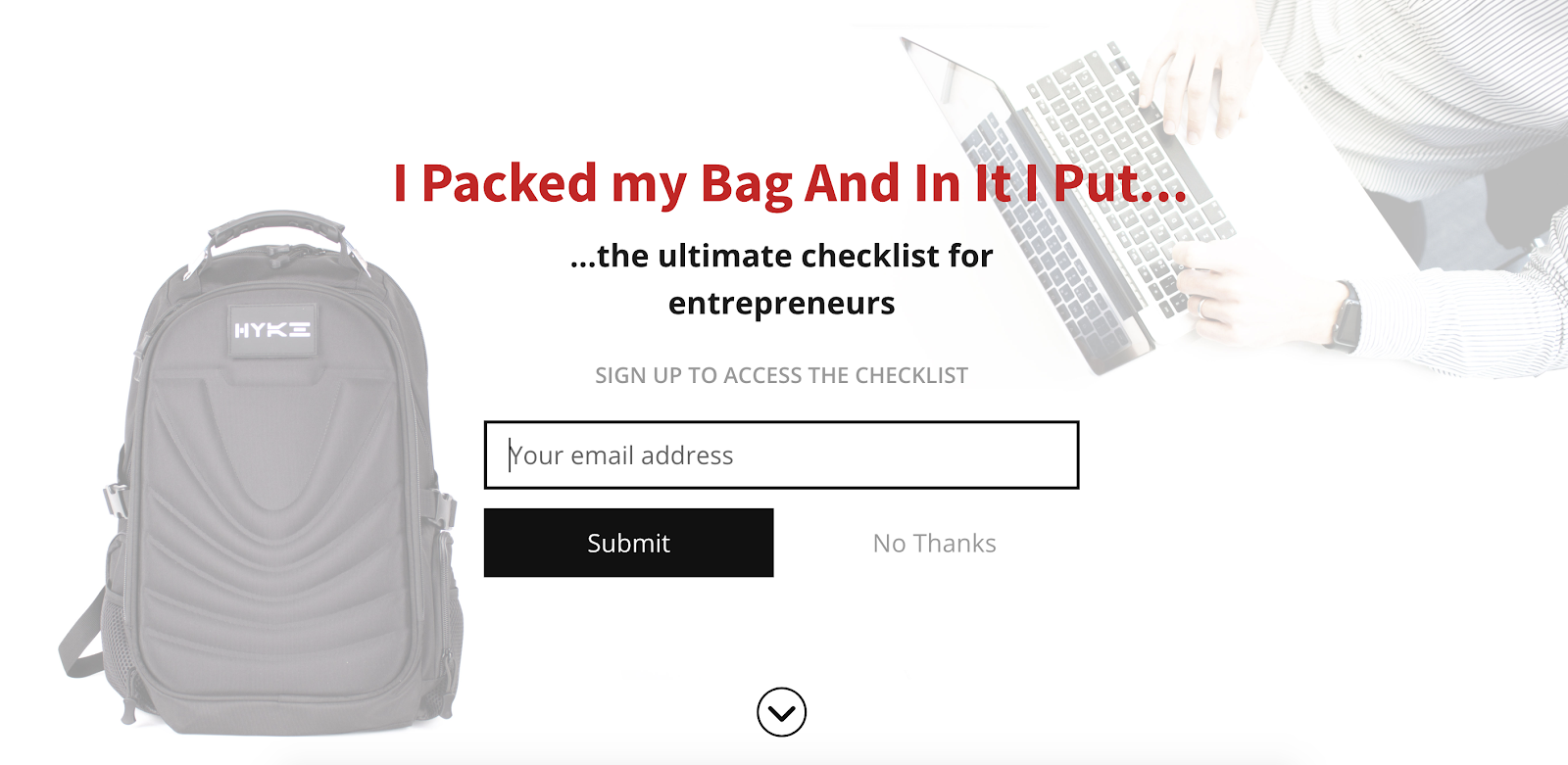
Settings-wise I set it up as an “Instant Landing Page” to prevent people from scrolling.
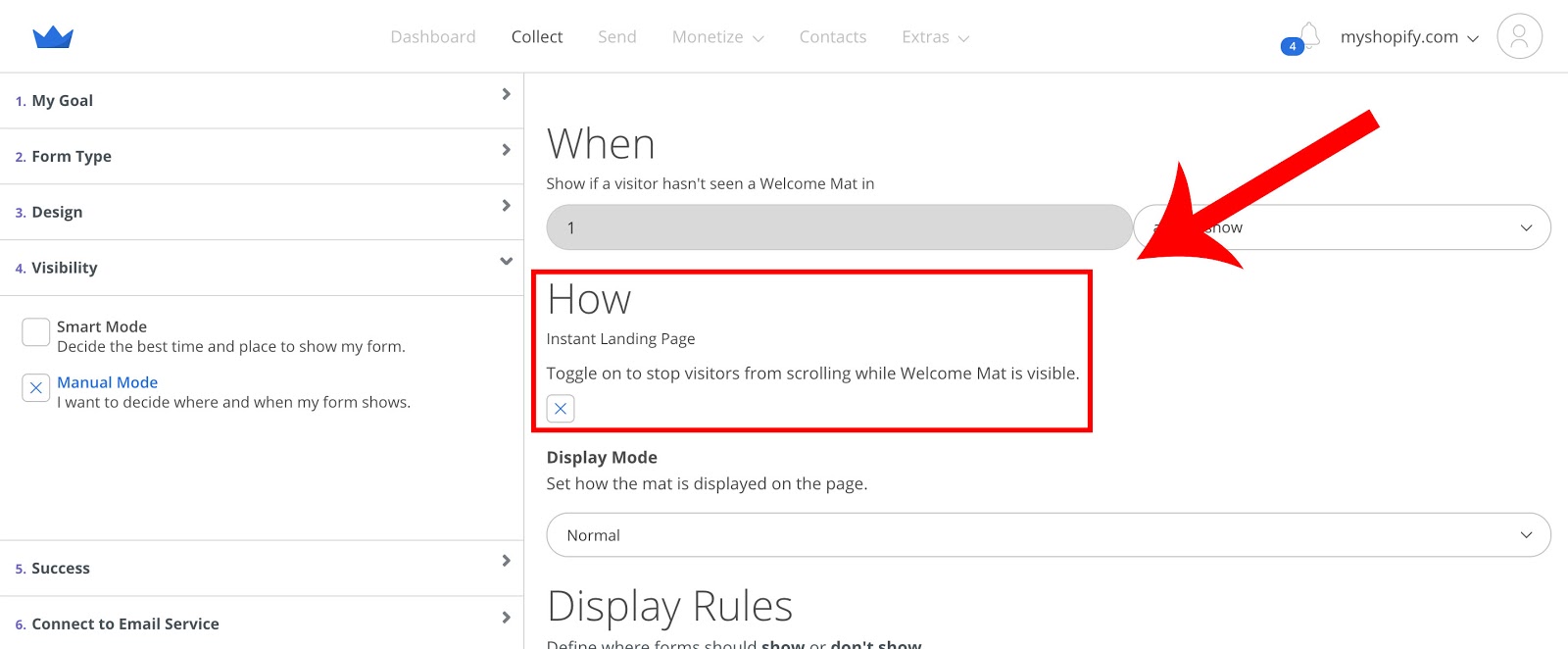
As soon as someone enters their email address Sumo will redirect them to the checklist (which is a simple blog post). Easy as a Sunday morning when using the Redirect URL feature inside Sumo (see below).
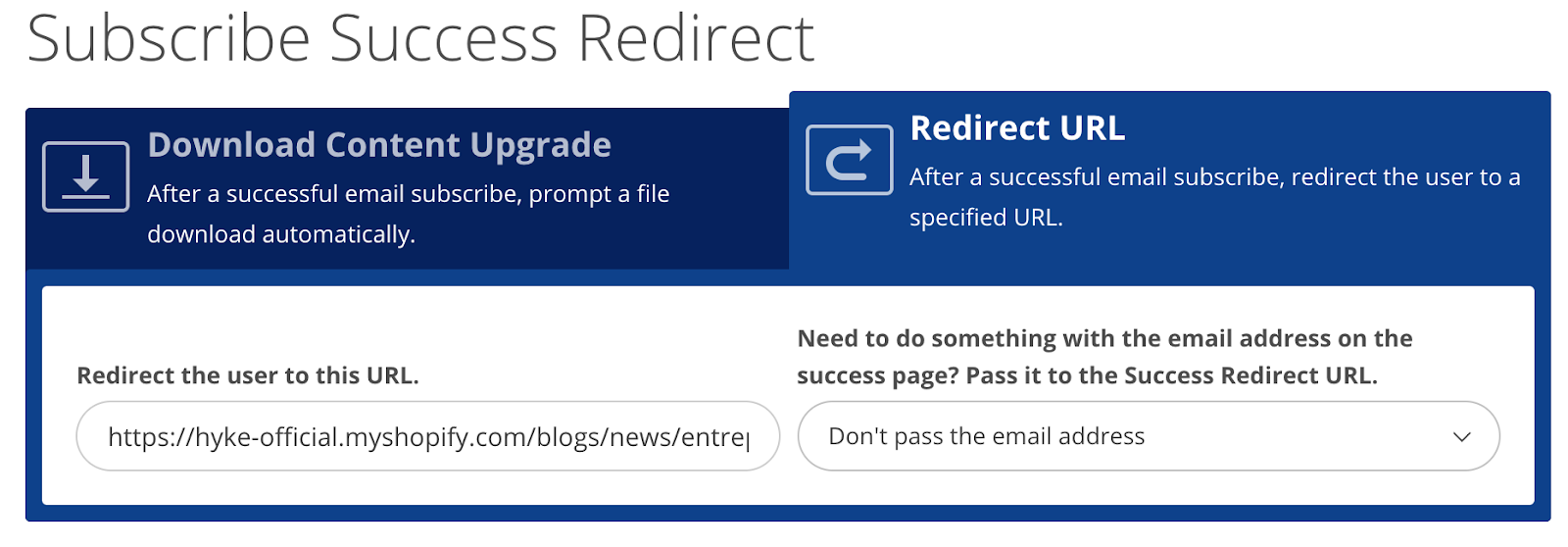
In order to get the ball rolling and start collecting email addresses, I reached out to everyone in my personal network who has an interest in the topic of entrepreneurship.

And that’s how I got my very first subscriber!

Additionally, I asked if they could share it with 1-2 people who they thought will benefit from it.

Note: I set up the Welcome Mat at the end of week four. To this day, there are just three people on the list. Growing the email list will come later when I drive traffic to my site from other marketing channels.
Another thing I wanted to do while waiting for my products to arrive was set up my social media accounts.
Setting Up My Social Media
I chose to go with Instagram, Facebook, and Twitter as these are the main social networks of my target audience. As I’m my own target audience and build the perfect customer avatar based on my personal preferences I picked my top 3 social networks.
I wanted to keep my Instagram page simple and not too salesy by promoting my backpacks all the time. That said, I decided to do four kinds of posts on my Instagram page:
- Funny memes
- Motivational quotes
- Re-posts of great images I like
- Promote my products
In week two I created a perfect customer avatar based on my personal preferences. So coming up with content themes was easy for me, because I know what kind of posts I like.
I started by writing an Instagram bio:
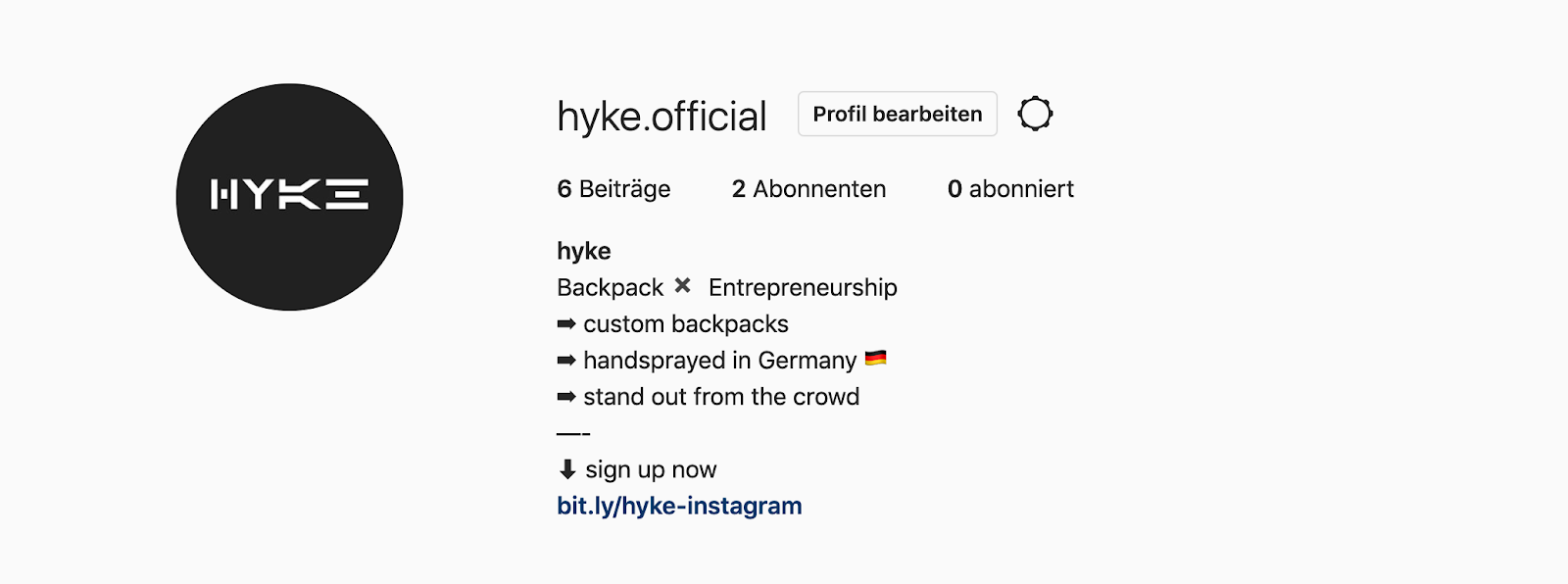
And uploaded six posts:
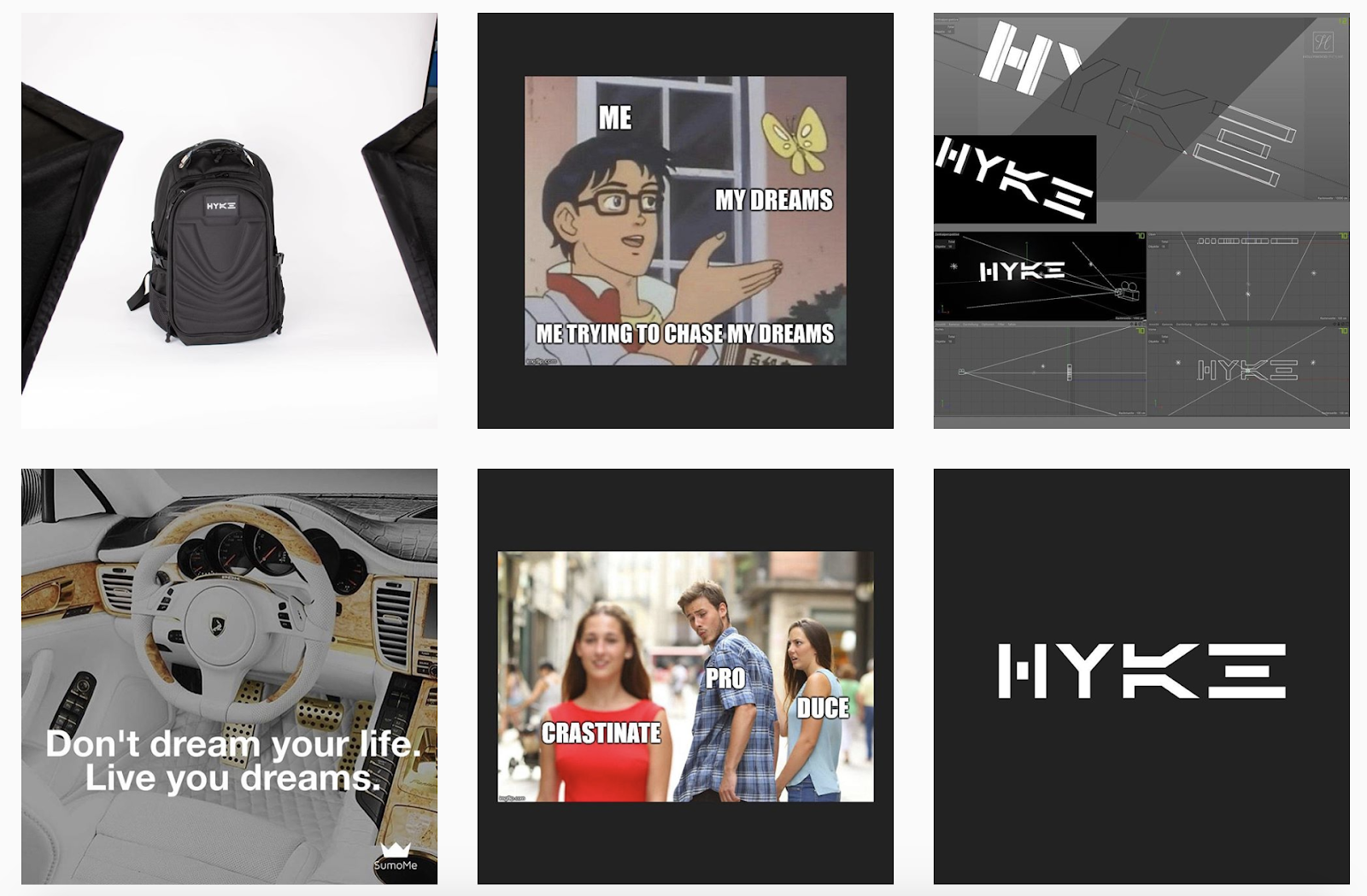
Obviously not the most perfect Instagram feed, but I just started.
My personal user behavior on Facebook changed in the last years. It went from engaging with friends on each other’s timelines to passively consuming information.
I use Facebook primarily for three reasons:
- Facebook Messenger
- Facebook groups
- Wasting time
Two out of the three points above are pretty useless for my marketing.
Facebook groups, however, could be something really interesting.
I could approach this two ways:
- Build a brand community which lets all my customers engage with each other.
- Build a community around a certain niche.
Building a niche Facebook group seemed like a better approach as I didn’t have any customers yet who could engage, and building a group around a certain topic attracts more people. It also helps me become an authority for that topic via content marketing.
The main reason I created a HYKE Facebook page was to connect it with Instagram to get an Instagram business account, and to connect my niche Facebook group to it.
Having the page as another distribution channel helps, too.
To begin with, I created the page and setup a Sign Up button which leads people to my Welcome Mat. I didn’t post anything.
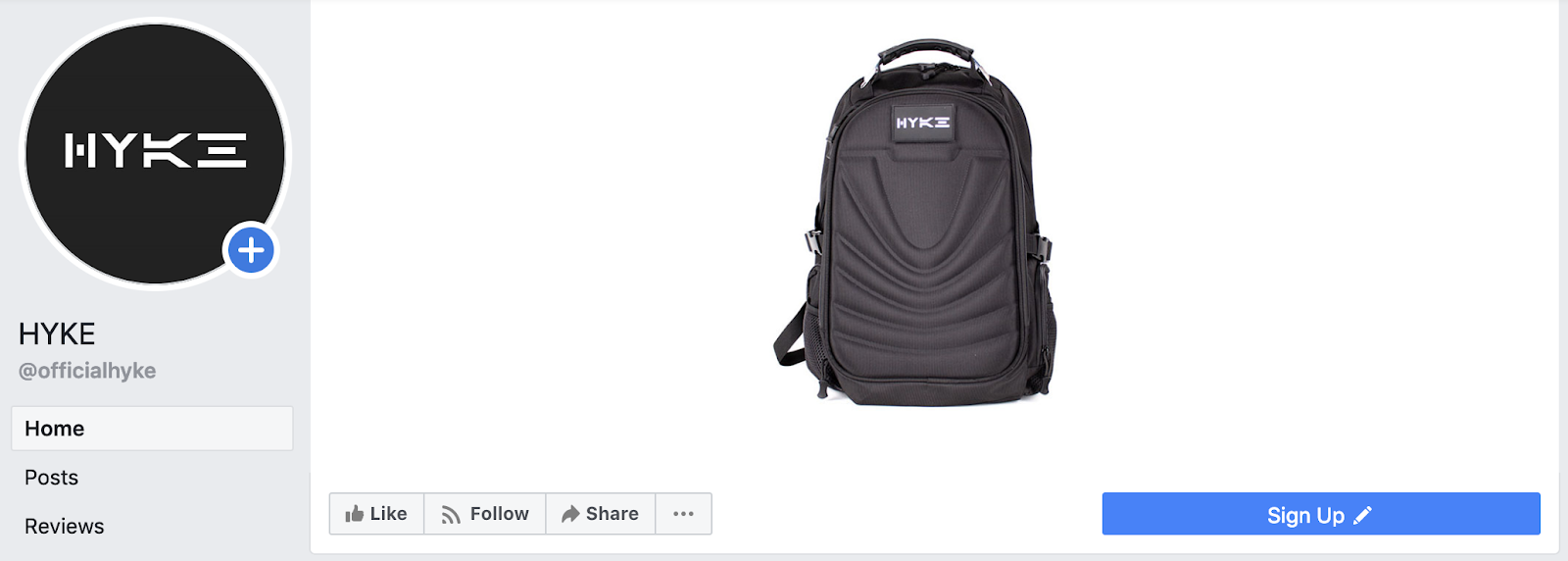
Like Instagram and Facebook – I wanted to set the page up and save my name.
A more strategic approach to growing the account will come later.
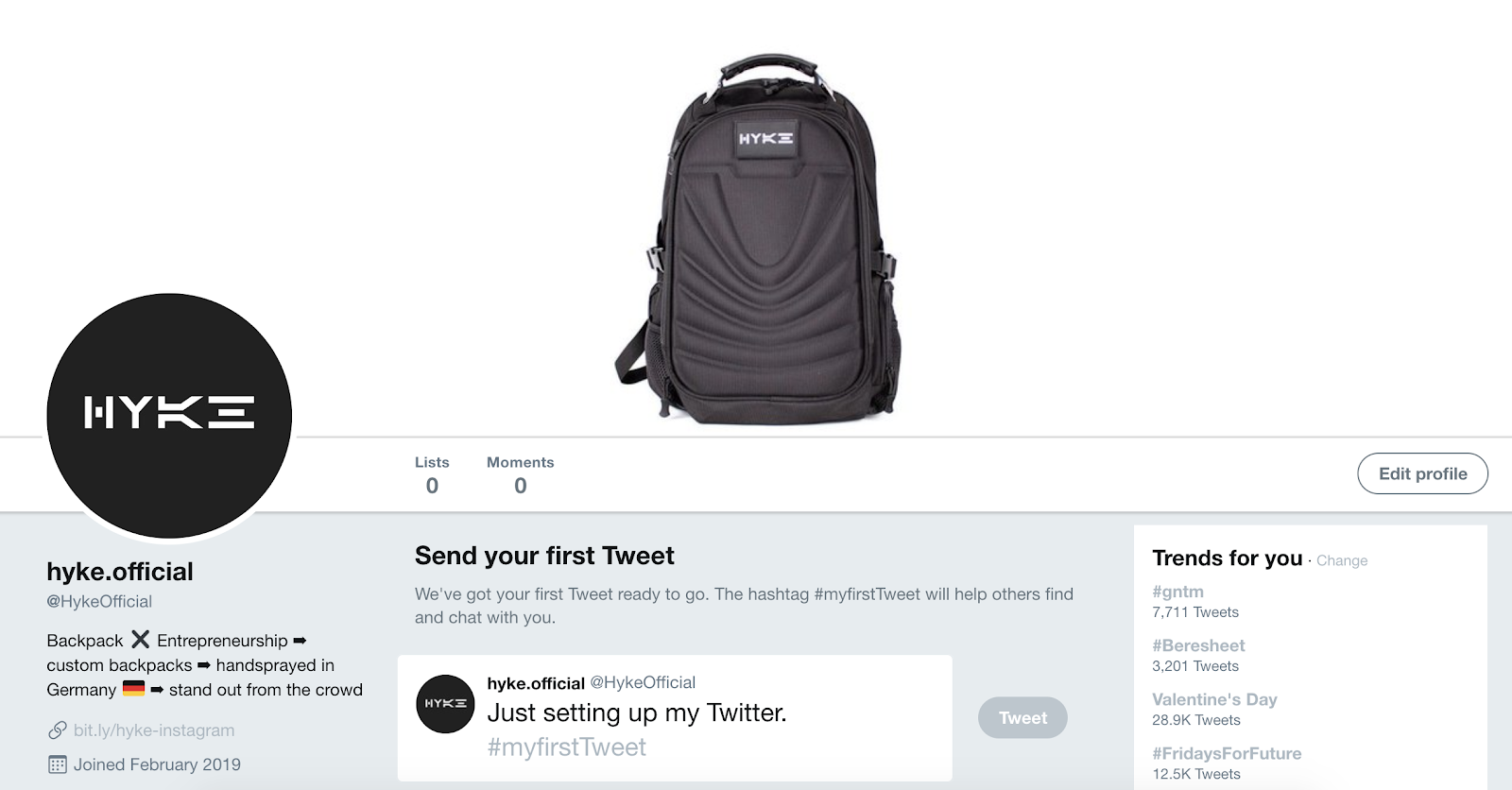
My planned Twitter strategy is split into two categories:
- Retweets on my target audiences posts (70-80%).
- My own tweets regarding products or content.
Setting up all three social media channels only took around 15-20 minutes.
My pre-marketing strategy on social media is to reach as many people as possible to get them on my email list. I don’t want to sell anything (for now).
Even though I did at least something in week four and didn’t let the delay stop me totally, this week felt very slow. But this is business some times.
Week #5: Building A New Shopify Store
Everything was slowed down dramatically due to my shipment delay.
I started to feel angry.
And, to make matters worse, the German military forced me to go on a four-week training. As I’m still an active soldier I couldn’t do anything against it. In those four weeks, I could only spend the weekends on my new business (and documenting it for this case study). From Monday to Friday I’m not even at home or have wifi access. There is a lot against me.
From now on I would have to be as productive as possible. There isn’t much time to waste. If you work a 9-5 job, and trying to get a new biz off the ground you’ll know the feeling.
But on Thursday evening of week number five, my girlfriend gave me a call which gave me some hope…
The Products Finally Arrived
“You owe me a nice dinner!”
That’s the first thing my girlfriend said on the phone. Not sure why she thought that, so I refused it instantly (I’m a good boyfriend, right?).
Turned out the products arrived at our apartment.
Okay, not really at our apartment. But at least downstairs (three floors down). As nice as the young German post-officer was, he didn’t want to help my girlfriend take the delivery upstairs. She did it on her own.
That’s why she thought I would like to pay for dinner.
“I don’t think 100 backpacks are that hard to take upstairs.” was my answer.
The next day, when I finally came home, I could see the packages in our apartment and knew I was wrong. Like totally wrong.
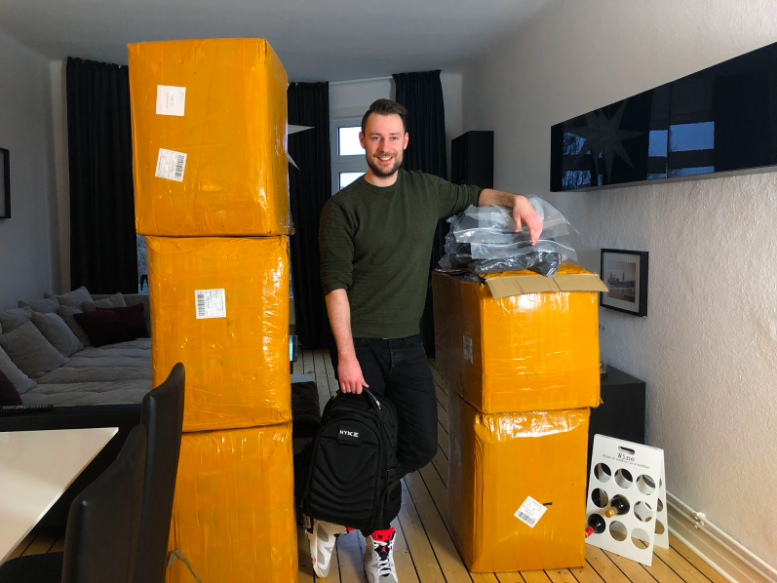
For comparison: I’m 1.90m tall; and each box weighs 21.3kg. My girlfriend is 1.72m tall and weighs 65kg.
I definitely owe her a nice dinner.
Anyway, I was super happy the products finally arrived!
The whole packaging was great and there was not a single damaged backpack. 100 perfect products.
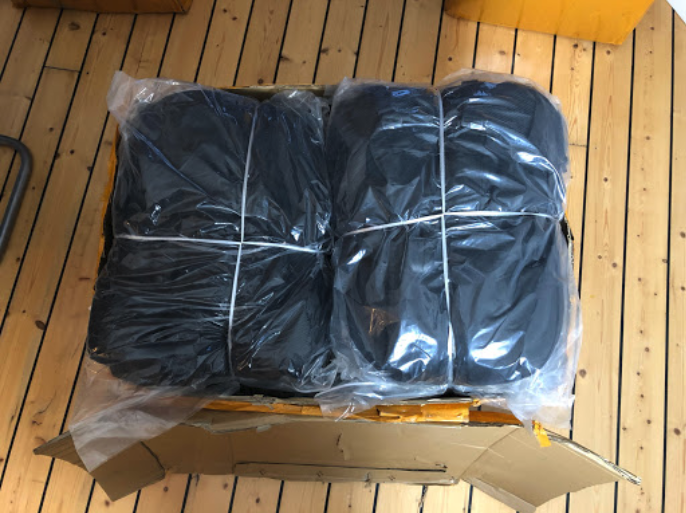
Even though my living room looked like a mess, I was glad I could finally move on with my business.
I only have around three weeks left to achieve my goal to make $1,000 USD in profit. And the online store is not even built.
That’s why I wanted to change this.
Building My Shopify Store
Even though I was ready to sell and ship the products, I couldn’t present the unique selling proposition (USP) on my website.
I didn’t have any images of final hand sprayed backpacks. I only had the clean ones from the photo shoot.
Unfortunately, this wasn’t something I could change very fast. I wasn’t at home Monday to Friday and didn’t have the time and place to spray the products at the military base where I had to stay for the training.
So I decided to build the Shopify store with placeholder images. Once I have some final sprayed images I will replace all the placeholder images.
I had about two hours left before I had to leave to get to the military base, so I set my goal to get some key parts done on the website:
- Shipping Zone
- Apps
- Product
- Theme/Design
- Custom Domain
***hustle mode***
Shipping Zone
As I’ve started my business in Germany and don’t have plans to expand internationally soon, I only set up a shipping zone for domestic shipping.
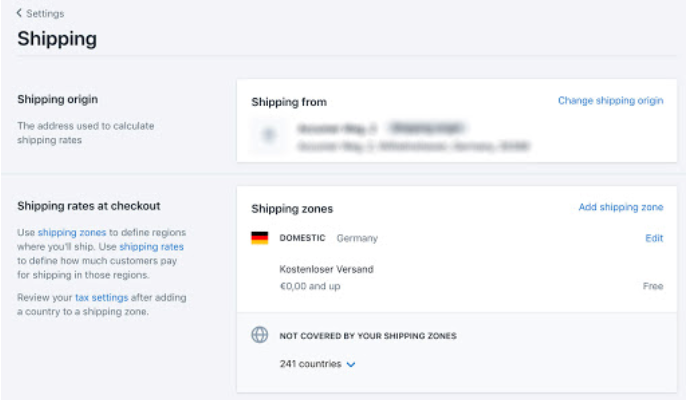
I set it up for free as I already included the shipping costs into my product price calculation. This allows me to advertise with “free shipping” which can help increase sale conversions.
Apps
For the initial setup of my store, I didn’t want to overtool it. I only wanted to have the most necessary apps for my online store.
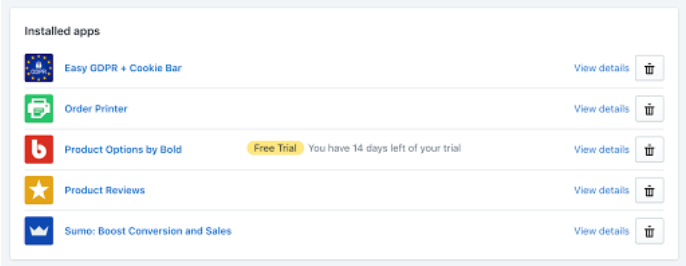
Easy GDPR + Cookie Bar
Price: Free.
As I’m selling to a European audience I have to make sure my store is GDPR compliant. This app allows the customer to request their personal data on my website and send a request to delete all collected data*
*Note: Only installing one app won’t make your store GDPR compliant. Please consult a professional.
Order Printer
Price: Free.
Once I receive orders I need this app to automate printing labels and invoices.
Product Options
Price: Free 14-day trial, then $9.99 per month.
As my product is a customizable product (colors and text) I need a way for my customers to submit their wishes.
It’s $9.99/month but definitely required for my type of business.
Product Reviews
Price: Free.
To get social proof, I added a review app so my customers can let other people know how they like the product.
Sumo
Price: Free.
As mentioned previously, I installed Sumo to be my #1 email marketing tool. It’s free until I make $500 sales vs other email marketing tools that charge based on number of email subscribers.
For now, those five apps are enough. I’m pretty sure there will be more apps in the future but I don’t even have a single sale yet so I don’t want to spend more time on setting up apps I may never need.
Product Page
Because I only have one product (for now), creating a product page wasn’t that time-consuming. I created a new product in Shopify, uploaded four product images, and came up with a simple product description.
Because I had to rush I didn’t have time to write a great description. I will change this later.

Product description translation:
Are you looking for freedom?
Do you want to live a life on your own rules?
Well, go pack your things together and just do it!
Whether you’re living a digital nomad lifestyle, going on a business trip, or want to take a break from the hustle – you need a bag which simply works.
If you need more individuality the custom HYKE backpack is the right one for you!
With time I will change the product description and images.
Also, because of my limited time that evening, I didn’t set up the “Product Options” app.
Theme/Design
I scrolled through all free themes on the Shopify theme store but couldn’t find one that had the options I was looking for. So I bought a theme for $49 USD.
I spent about one hour arranging the theme sections:
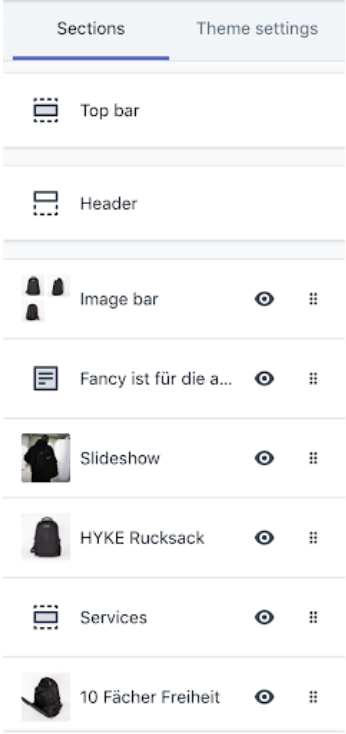
By the end of the hour I had my front page design ready:
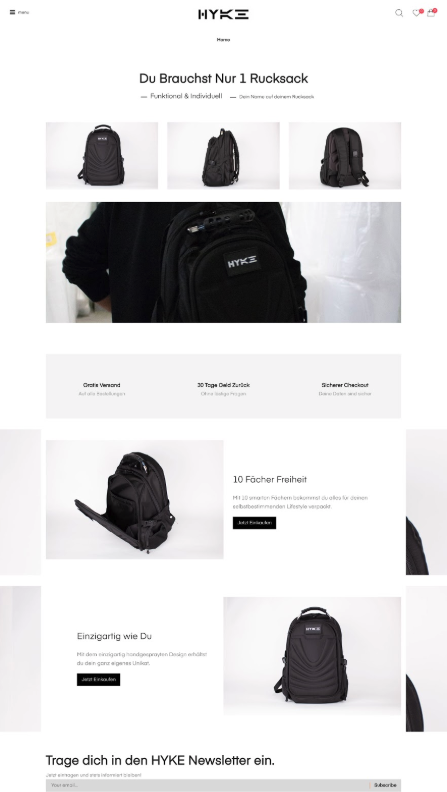
Again, this is far from the final design.
My main goal for the front page design was to let visitors instantly know what the business is about.
Translation of the first lines:
“You just need 1 backpack
– Functional & Individual – Your name on your backpack”
I think it’s obvious I sell backpacks.
Custom Domain
Unfortunately, hyke.com was taken. So I had to come up with an extension to “hyke”.
I chose to go with www.hyke-life.com as it expresses the business the best. I want to build my business around the freedom-seeker-lifestyle movement.

After purchasing the custom domain I finished everything I wanted to finish that evening.
Even though I’m slowly but surely running out of time and things are not running smoothly, I’m happy I could start selling and shipping!
Week #6: Making The First Sale
Everything became a bit overwhelming.
Slowly but surely I lost control.
I had two options:
- Pause the project until my military training in the German army is over (and don’t reach my goal) OR
- Ask for help.
I hate not reaching my goals, so I had to ask for help.
Asking For Help
Not being able to work on HYKE from Monday to Fridays made things very difficult. Like I already said, I could’ve stopped the whole project until the training is over but I didn’t want to lose momentum.
So I called a good friend and business partner of mine to ask if he’d like to join me. I told him about the project, showed him my plan and he agreed. We even split the costs of the backpacks ($1,197.50 USD each) so we’re equal partners.
Obviously, my personal profit is now less than it was before, but having a partner on my side can become very helpful (even after I finish my training).
For now, he will take care of executing the marketing plan I mapped out earlier:
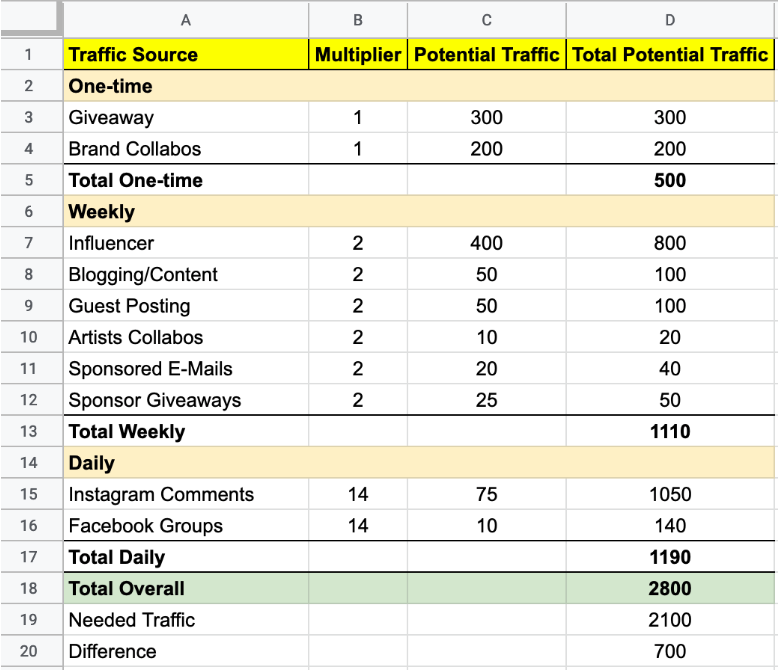
With only three weeks left to achieve the goal of making $1,000 USD in profit, we focused on the things which are the easiest to execute and probably have the biggest impact in a short period of time.
This left us with:
- Giveaway (to build our email list)
- Influencer outreach (to get attention on social media)
- Instagram comments (to get attention on Instagram)
We made this decision based on our previous ecommerce experience with free marketing tactics. Paid marketing is, in our opinion, only great to grow/scale a business. As we’re far away from thinking about growth, we’re sticking to free marketing for now.
Business Is All About Making Decisions
The difficult thing about marketing our product is that we can’t actually show what we sell. We still only have the pictures from the blank backpacks, no customization at all.
Having those time limitations to work on HYKE, I couldn’t even see a date when I had time to do proper test painting and photo shooting.
That said, I made a clear decision: we don’t customize the products (yet).
We will start by selling simple, but still great looking products. The customization will come later. Period.
Because of that decision, I had to make some minor changes on the website.
Tweaking My Shopify Store
There were certain words all over the website which contained the word “custom” and “individuality”. As the products USP (unique selling proposition) now changed, those words had to be removed/replaced.
I tried to create an un-fancy Shopify store which represents an elegant and simple style.

As you can see on the image above, I didn’t just change the wording. I also added a new product: a snapback.
I added the snapback for two reasons:
- Low-barrier entry (to get people hooked with the brand for a lower price)
- Cross-sell product (to increase the average order value)
Because the snapbacks are not our key-product we didn’t choose to purchase them in bulk up front. We used a print on demand service called Printful. As soon as someone orders that snapback at our online store, Printul will print the cap on demand and ship it to the customer.
This is an easy way to get started, but if there’s an increasing demand we will purchase snapbacks in bulk to be able to offer faster shipping and better customer experience.
The integration with Shopify works very smoothly via their Shopify app.

I only had to upload the HYKE logo and the app automatically created a mock-up.
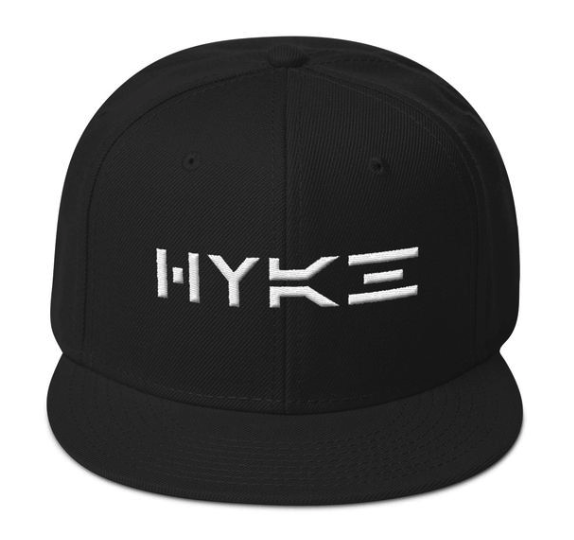
Quality-wise I knew that the snapbacks from Printful are top-notch. I’ve worked with the app before and tested the quality of their snapbacks.
I don’t know the quality of their other products, so we decided to not blindly sell other products for now.
Having changed the website a bit, we also decided to change the Instagram account.
Making Changes On Instagram
When I first uploaded content on Instagram, I made the decision to upload funny memes, motivational quotes, re-post great images and promote my product.
As the website and the overall brand image now changed to a more simplistic look, the Instagram account should also match that look.
I removed almost all images and uploaded the pictures I currently have of the backpack.

For now, we looked at Instagram as another form of a sales page.
Real social media marketing (i.e. engaging with other people or strategically using Instagram stories) is something we will consider once I finish my military training.
The first real marketing step we took was to start a giveaway at the end of week six.
Running A Giveaway
Even though social media is great, I still prefer email marketing for all my ecommerce websites. Being able to reach potential customers whenever I want with one click is incredible. With an email list, I don’t have to pay for ads or be worried about getting my ad account shut down.
Running a giveaway in order to build an email list from scratch is probably one of the most effective ways. So that’s what we did.
Because we tried to reach entrepreneurs, we decided to giveaway one HYKE backpack filled with 10 top business books:
- Rich Dad, Poor Dad
- How to Win Friends & Influence People
- Creativity, Inc.
- The Why Are You Here Cafe
- Crushing It
- Steve Jobs
- Eat That Frog
- Think and Grow Rich
- The Big Five For Life
- The Four Hour Workweek
All books together are worth more than $150 USD (+ the HYKE backpack). I picked the books based on my personal preferences. It’s definitely a giveaway I would love to win.
We used KingSumo to run the giveaway. This gives us the ability to make it a viral giveaway as contestants can receive more entries for taking certain actions (e.g. referring a friend).
Here are the exact giveaway settings we setup inside KingSumo:
-
Duration: 1 week
-
Winners: 1
-
Sharing Options: Facebook, Email
-
Bonus Entries: Come back every day (2), Instagram follow (2), visit website (2)
-
Integrations: SendFox

In order to promote the giveaway we did three things:
-
Embedded a badge on the website.
KingSumo made it easy to do this. They provide the code and I only had to copy/paste it into my website’s HTML.
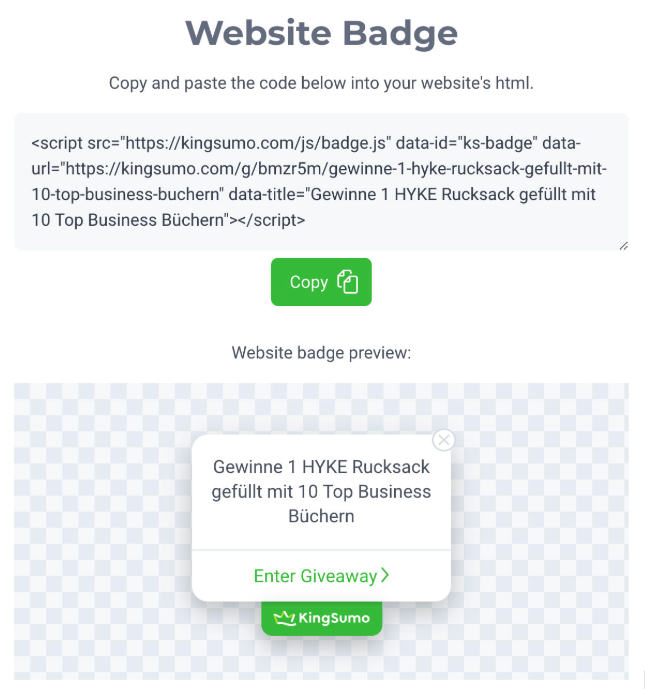
In Shopify: Themes > Actions > Edit Code.
Put it before the closing </body> tag.

This is how it looks on the website:
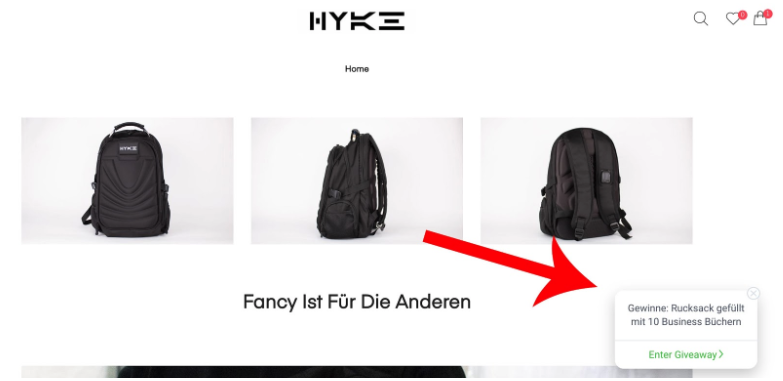
-
Put a link to the giveaway in our Instagram bio.

-
Shared it on my personal Facebook page.

Translation:
For opening a new online store I’m running a giveaway: 1 backpack filled with 10 business books.
Whoever wants to win a backpack filled with a ton of knowledge should enter – it’s worth it!
We also promoted the giveaway pro-actively on Instagram.
Instagram Comments
As already mentioned, we want to leave comments on our target audience’s Instagram posts to get their attention.
Here’s an example:

Translation:
Education definitely makes sense! Hope you had a great day on your seminar!
PS. We’re currently running a giveaway where you can win a backpack + 10 business books!
With the first line we reacted to the image and description of the original post and with the second line, we promoted our giveaway (this gets people to checkout our profile and click the link to the giveaway in our bio).
We did this 75 times that afternoon and then something special happened.
The First Sale
*Ka-Ching* – that’s the sound the Shopify mobile app makes if someone purchases something from your online store!
Even though we heard this sound probably thousands of times before with other stores it was the first time we heard it coming from HYKE. It felt amazing!
Someone purchased our backpack on the first day of doing some marketing.
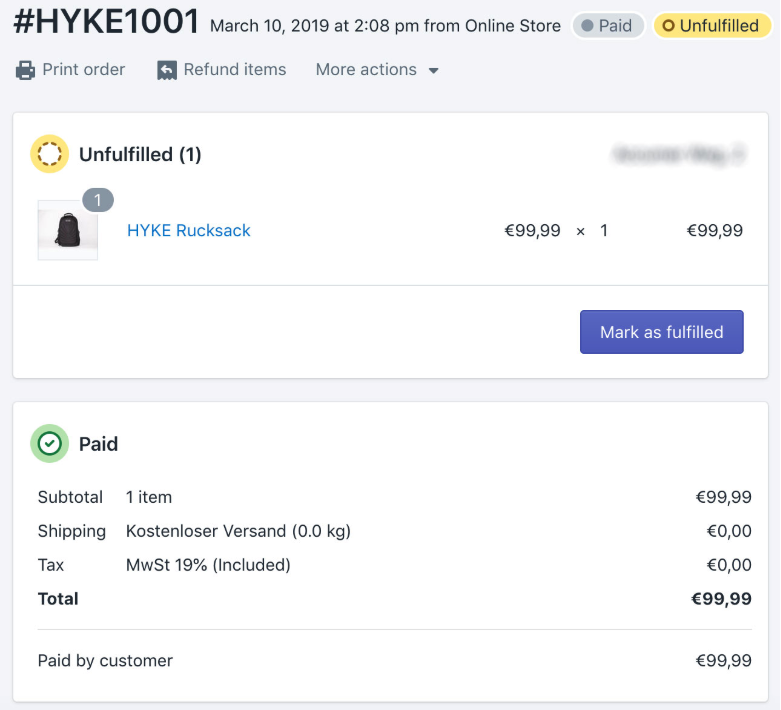
It couldn’t be better!
Now was the time to fulfill the order and ship the product to the customer.
Week #7: Product Fulfillment, Influencer Marketing, And Instagram Comments
I’m seven weeks into the journey of building a new brand from scratch and it already feels like a rollercoaster.
From the high feelings of receiving my first product sample, to the down feeling of receiving the letter of the German military that I have to leave for training.
However, with necessary adjustments, I had my first customer.
This doesn’t only mean I would make money, but means somewhere in Germany (actually not far away from me) my customer will carry a product from a brand I only started seven weeks ago.
It felt great.
Fulfilling The First Order
To get the product to our first customer, we had to fulfill the order soon. We didn’t want him to wait long. We wanted him to receive the best possible experience with HYKE.
I used the free Shopify app Order Printer to print the invoice and packing slip. With a few clicks I had everything ready.
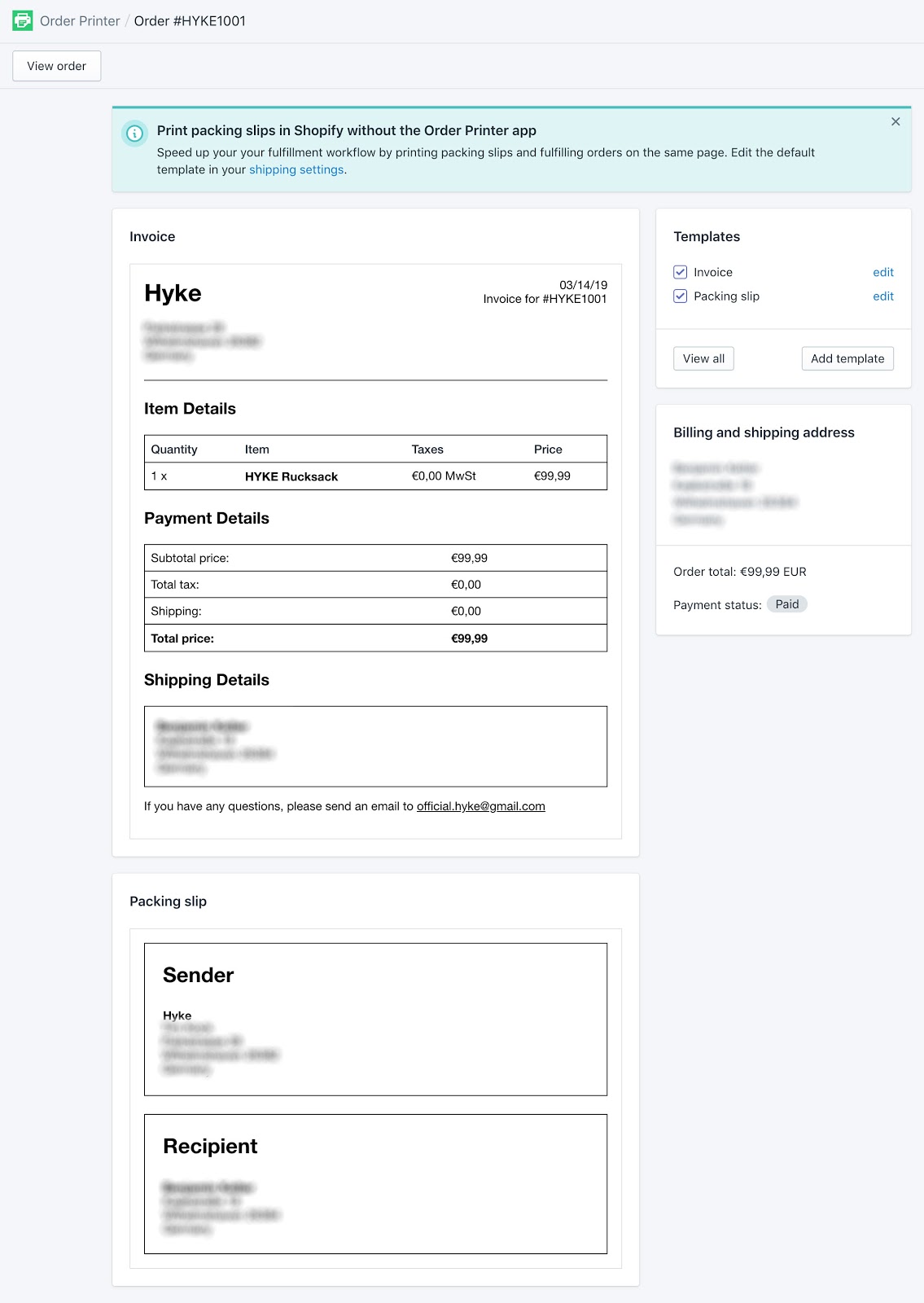
I put the invoice into the package for the customer, attached the packing slip on top of the package and kissed it goodbye!
At the point where I shipped the product to our first customer, we are still far away from what packaging should look like. The 75 blank packages I recently bought for €35.25 ($40 USD) were shipped back to the supplier because I wasn’t at home to receive them (because of my military training). So we had to ship the product in an expensive DHL package (around $3.20 USD) from the local post office.
Also, there’s no dust bag yet to protect the backpack from dust and to make it look more exclusive.
Long story, short: our packaging sucks at the moment.
However, there was something we could do about it in a short period of time.
Getting Stickers And Tape For Custom Packaging
To get at least some kind of custom packaging, I decided to order stickers and shipping tape with the HYKE logo on it.
Having had some good experiences with Sticker Mule before, I decided to order 100 rectangle roll labels for €61.00 ($69 USD).

Here’s what the stickers look like:
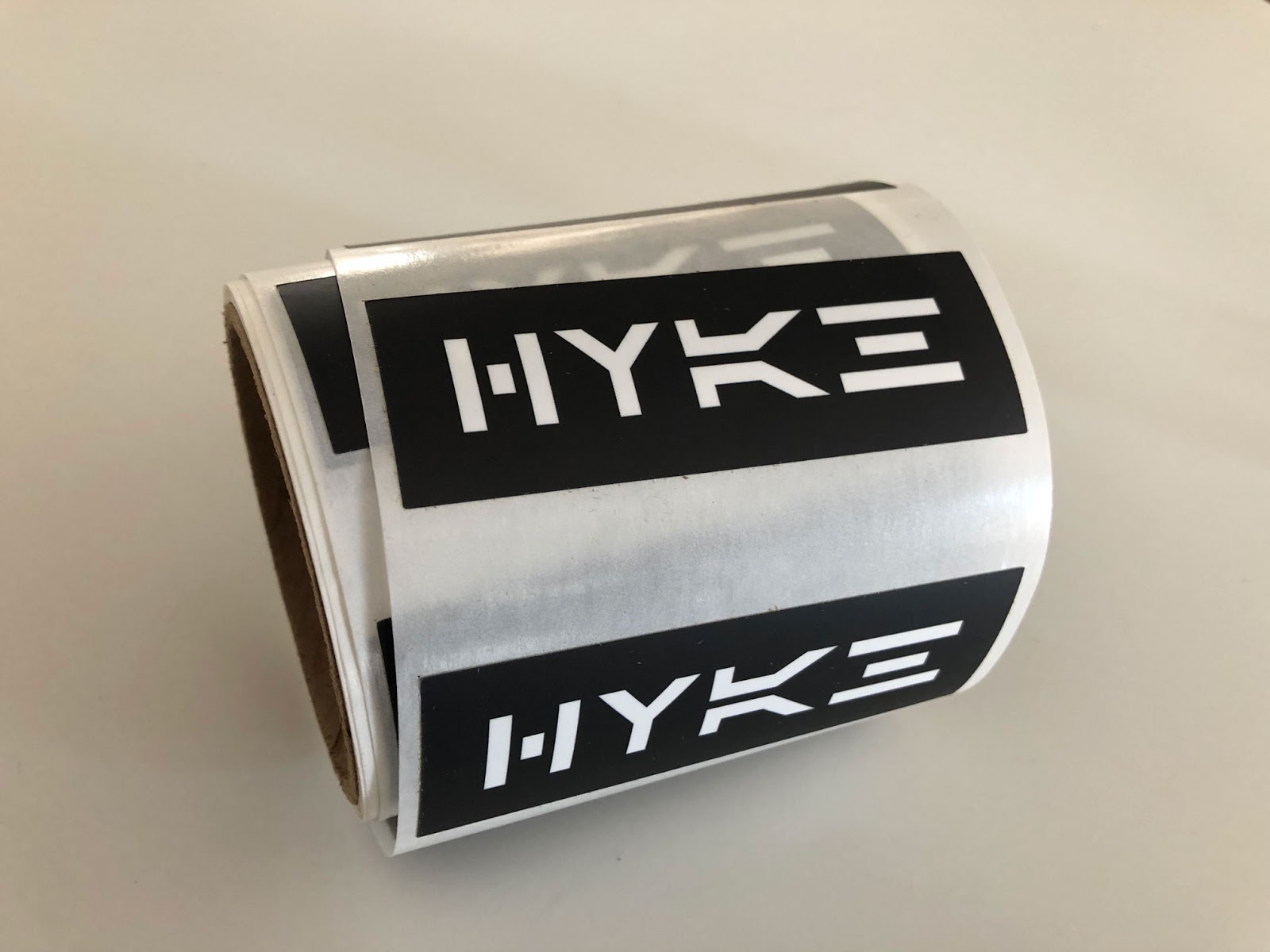
I also ordered 91m of packaging tape for €41.29 ($47 USD).

Here’s what the shipping tape looks like:
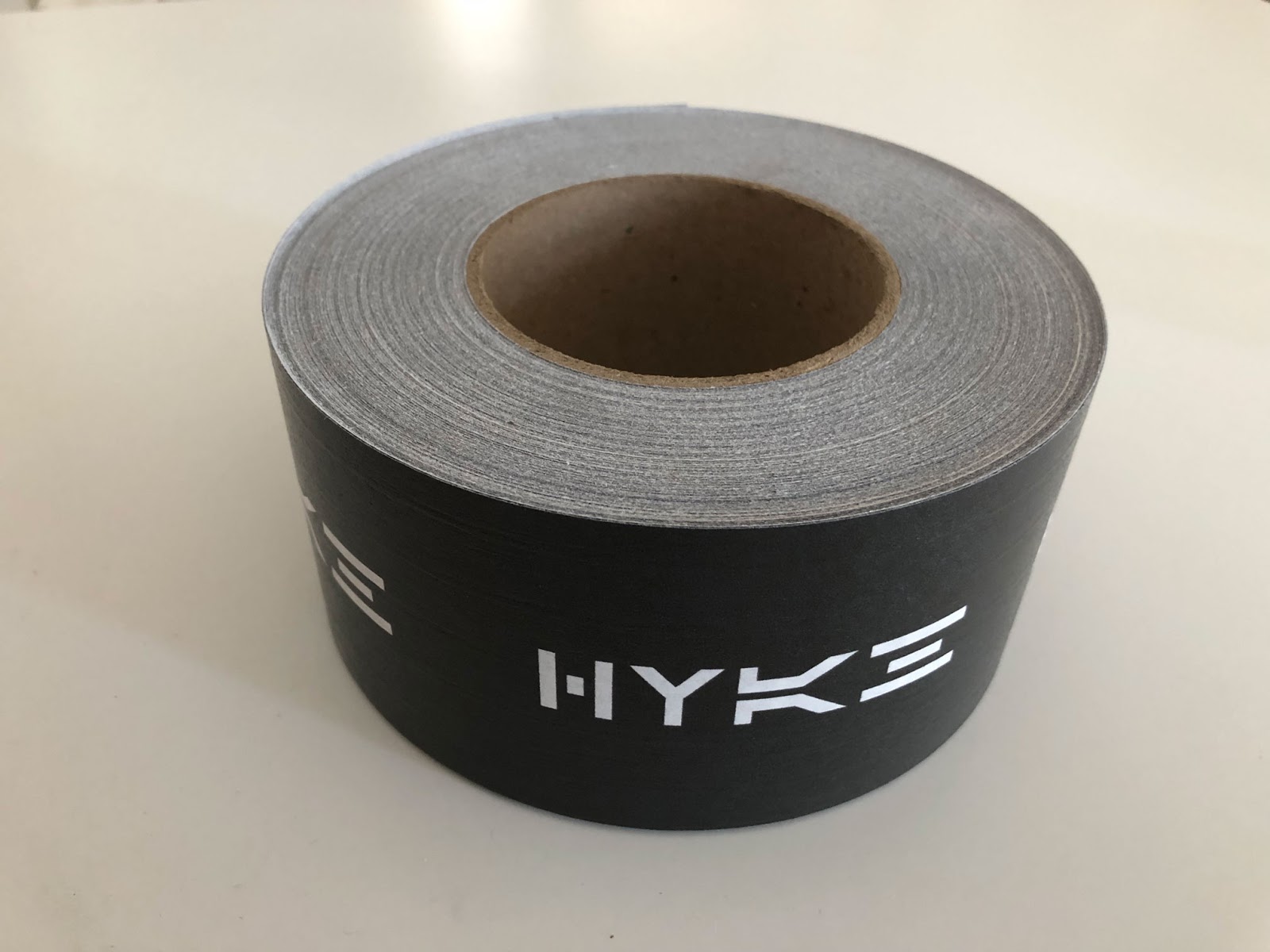
To get the stickers and tape delivered to my house will take around 10-12 days.
To avoid having the products shipped back to the supplier again, I shipped the products to my partner’s house.
Now I had packaging organized, it was time to take care of marketing again.
How HYKE Does Influencer Marketing
When talking about “influencer marketing”, most people think about sending products to hot girls on Instagram with a ton of followers.
That kind of influencer marketing would never work out for us. We would only waste our time and money. But we were keen to collaborate with an influencer.
A very common approach to influencer marketing is to look at the follower numbers, check the engagement rate, send a free product to the influencer and give them a discount code for their followers to purchase the product.
The intention of the above-mentioned approach is very obvious: direct sales.
We didn’t want to go that way. Our intention with influencer marketing is to spread the word of our brand. We want to get known, not make direct sales and so we took a quite different approach.
We looked for someone who matches with our values and is 100% authentic. Then, we reached out and asked if he is interested in getting a free backpack in return for honest feedback.
We didn’t ask for pictures which are like “hey, this is my new backpack. It’s the best backpack on this planet. I feel more masculine wearing it. My girlfriend thinks I’m hotter because of this black backpack”.
If he honestly doesn’t like the product he can give it away for free or ship it back to us. We trust in the quality of the product and don’t feel uncomfortable doing it this way.
Wanna see who our influencer is?

Dominique Schaak, a young professional race driver.
He’s a very friendly young guy and also matches with the values of HYKE:
- Passionate
- Talented
- Hard working
- Authentic
- (Likes Lamborghinis as all entrepreneurs do)
Figuring out if someone has the right personal qualities that match your business can be hard at times. As we described our business values, it was easy for us.
We followed Dominique on social media, and checked his website and race results to find out if he was actually passionate, talented and hard working.
He only has slightly above 3,500 followers on Instagram but as I said, we don’t care about these numbers.

The moment I’m writing these lines we don’t have a picture of him wearing the backpack yet.
Besides getting that great collaboration, he even invited us to one of his next races in the VIP lounge.
For now, we could only wait for the pictures. Once we get them we will use them on social media and our website. Car racing appeals to many people, and we want to attract that specific group of people.
So we moved on with our marketing.
Sales, Sales, Sales
Due to the limited time to achieve the $1,000 in profit goal, we mostly focused on Instagram comments like described in the previous week. We looked up people on Instagram using certain hashtags related to our target audience (#entrepreneur, for example) and commented on their posts. We tried to engage with them.

Translation:
“Awesome! We’d love to collab with you! If you’re interested just send us a message here on Insta”
We identified the hashtags by thinking about our target audience. For example, we target entrepreneurs. So we used the hashtag #entrepreneur.
If we targeted horse riders, we probably would have used #horserider.
Doing this over and over again is very time-consuming. But we’re starting from scratch and have to do the hard legwork now.
At the end of the week, we were able to make four more sales by doing this.
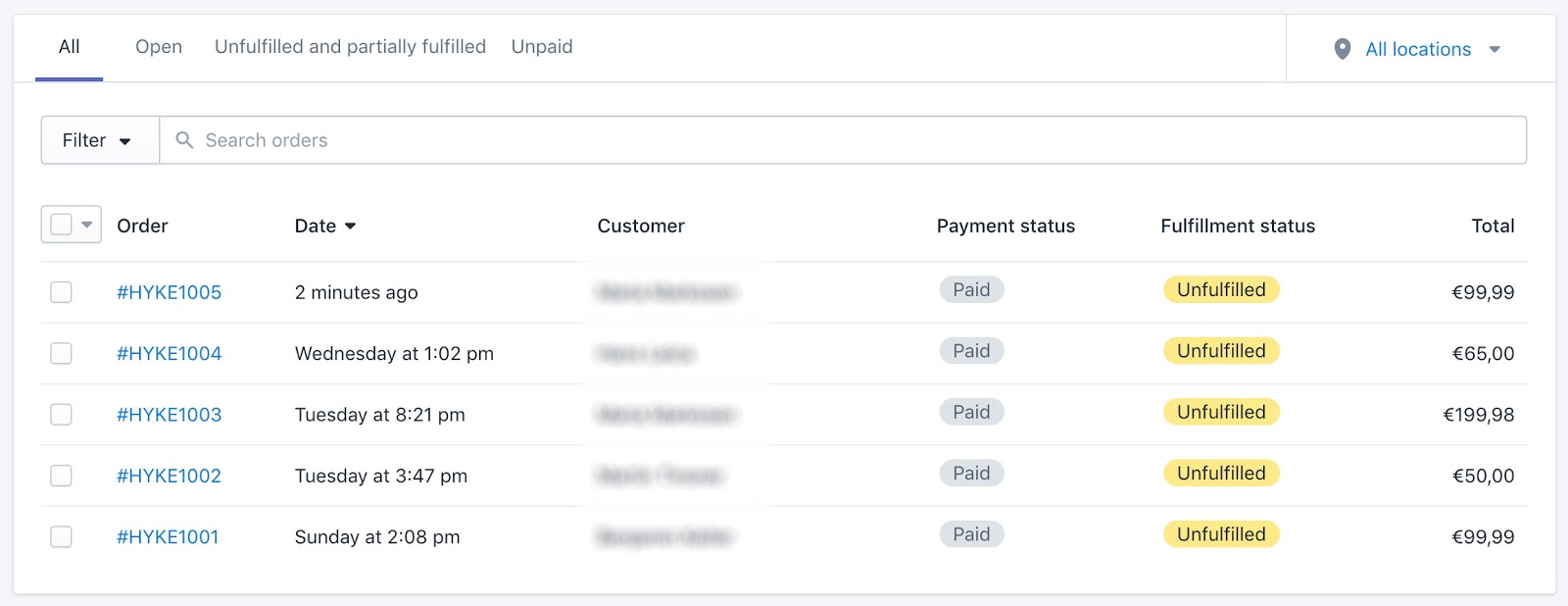
As you can see in the image above, one person even bought two backpacks!
So far we’ve made €514.96 (around $580 USD) in sales.
Obviously, doing this for sales is not scalable. But that’s not the intention. We want to:
- Validate our business.
- Get known by people on the internet.
As you may know from the previous week, we ran a giveaway to start building our email list.
Giveaway For An Ecommerce Business
Email marketing should become one of our main marketing channels. To be successful in email marketing you need a few things. But first and foremost you need a list you can communicate with.
So we ran a giveaway to get started. We gave away a HYKE backpack filled with 10 business books.
Note: At the time I’m writing this the giveaway has not yet ended, so the final results might be different.
By (almost) the end of the giveaway, we collected 65 email addresses.

Sure, this is probably not the best result ever BUT: 65 > 0.
And we learned a lesson: our target audience doesn’t seem to be interested in business books that much.
The thing that disappoints me the most with this giveaway is the fact that we didn’t promote it well. We just threw it out and hoped for the best.
I’ve achieved great results with other giveaways for ecommerce businesses, but for those giveaways I took a little action on the marketing part. We could only blame ourselves here for not putting together a list of marketing activities to promote our giveaway.
Anyway, we still have 65 new emails.
My military training will finally end next week and I’ll be able to hop back on the project again with more time.
Week #8: Making $1,000 Profit
It was actually scary.
We only had one week left to achieve the goal of making $1,000 USD in profit.
So far we made around $580 USD in sales, not profit.
In other words: we were far away from reaching the goal.
Email Marketing: The First Effort
We made the first five sales via Instagram comments and direct messages. Actually not bad. But not the way we want to continue our business.
For the purpose of validating if strangers will buy our product, it’s a good way. But as we’re looking for long-term success with HYKE, we wanted to focus more and more on email marketing.
For us, it’s the #1 marketing channel for an ecommerce business.
Last week, we collected email addresses via a giveaway. After the regular giveaway period, we collected 65 emails.
Within the last 5 days, 24 more people entered their email addresses. They signed up from visiting the page that appears after our KingSumo giveaway ended (to get notified of future giveaways).
So we had 89 emails. Not bad.

Awarding a winner is very easy and straightforward with KingSumo.
Usually, we would have sent an email to the winner and that’s it. But we chose to go with a different approach.
Again, we stole this idea from Chief Sumo Noah Kagan himself.
In a project where he grew a website to 10k visitors in 30 days (without taking advantage of his personal network), he helped a non-tech dude grow his website. One way was to run a giveaway to grow his email list.
We already did this.
To get more traffic to his website they created a simple page including a winner announcement and one reading suggestion.
We did pretty much exactly the same.
We sent an email to all participants telling them where to find out if they won the giveaway.

Translation:
“And the winner is…
We finally found the winner of our HYKE Backpack (+ 10 business books) giveaway.
To find out if you won, click here.”
This took people to a simple page with a small winner section at the top, and a bit of copy for a reading suggestion.
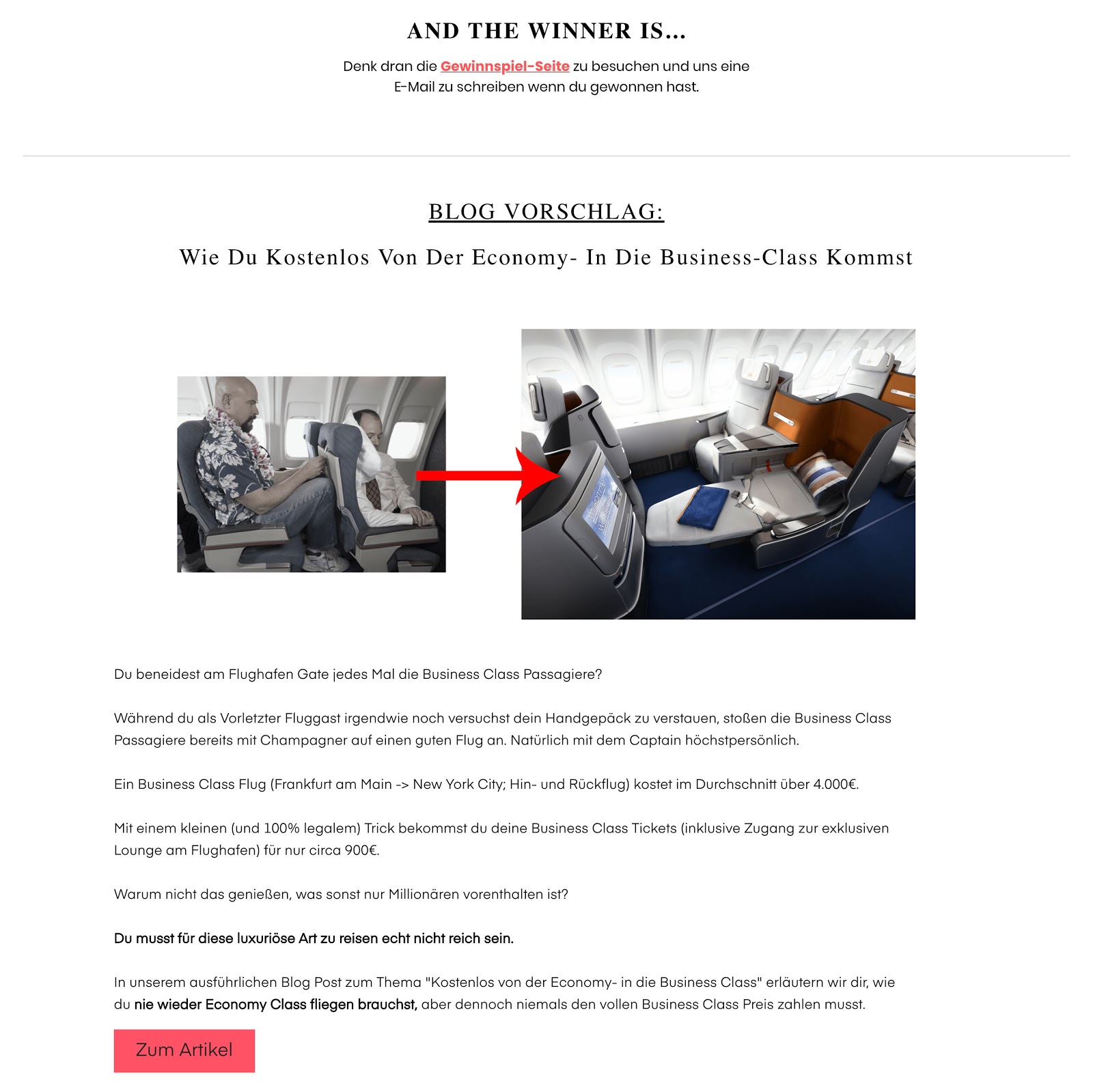
The link in the winner section at the top of the page takes people to the giveaway page.
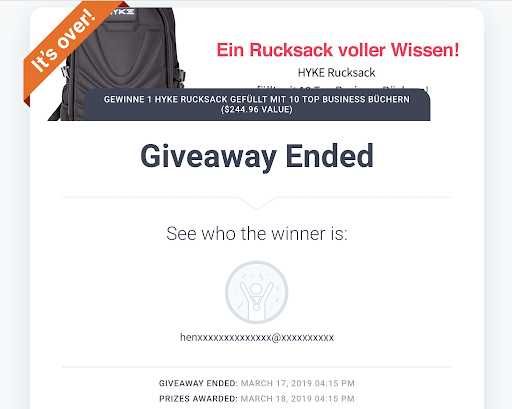
And the red button (“Zum Artikel”, translation: “to the article”) takes people to a blog post about “how to get from economy class into business class for free”.
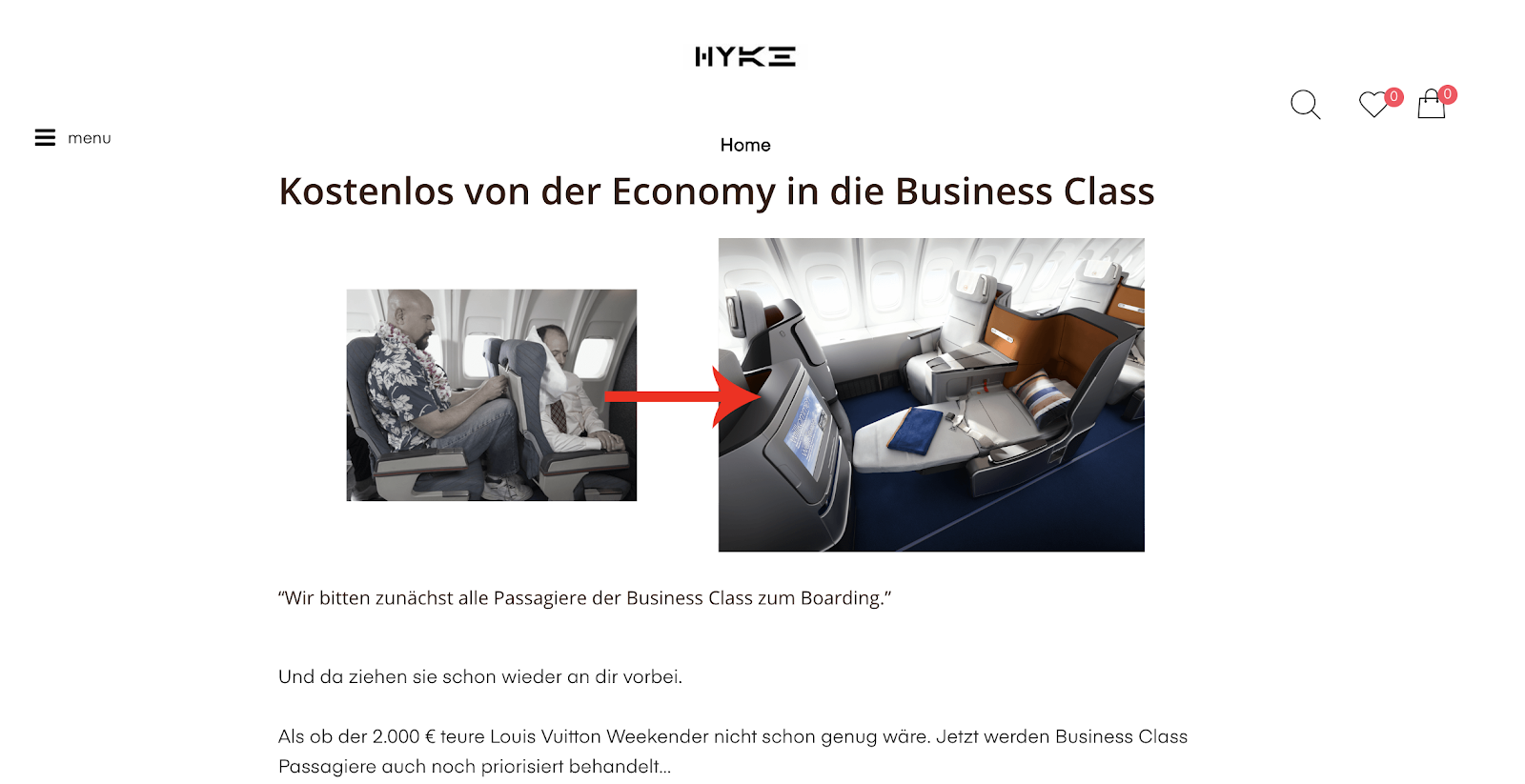
It’s a short blog post about how to easily collect miles with credit cards and certain other things to get free upgrades at Lufthansa (Germany’s largest airline).
I chose to write about this topic as I have some knowledge about it, and it works great with my target audience research.
Making Sales From A Giveaway
As we now had an email list of 89 potential customers, we wanted to take advantage of it.
The second email we sent was also related to the giveaway. We gave all participants a consolation prize: a 30% discount on HYKE products.
We excluded the email of the winner and sent a simple email to our list:
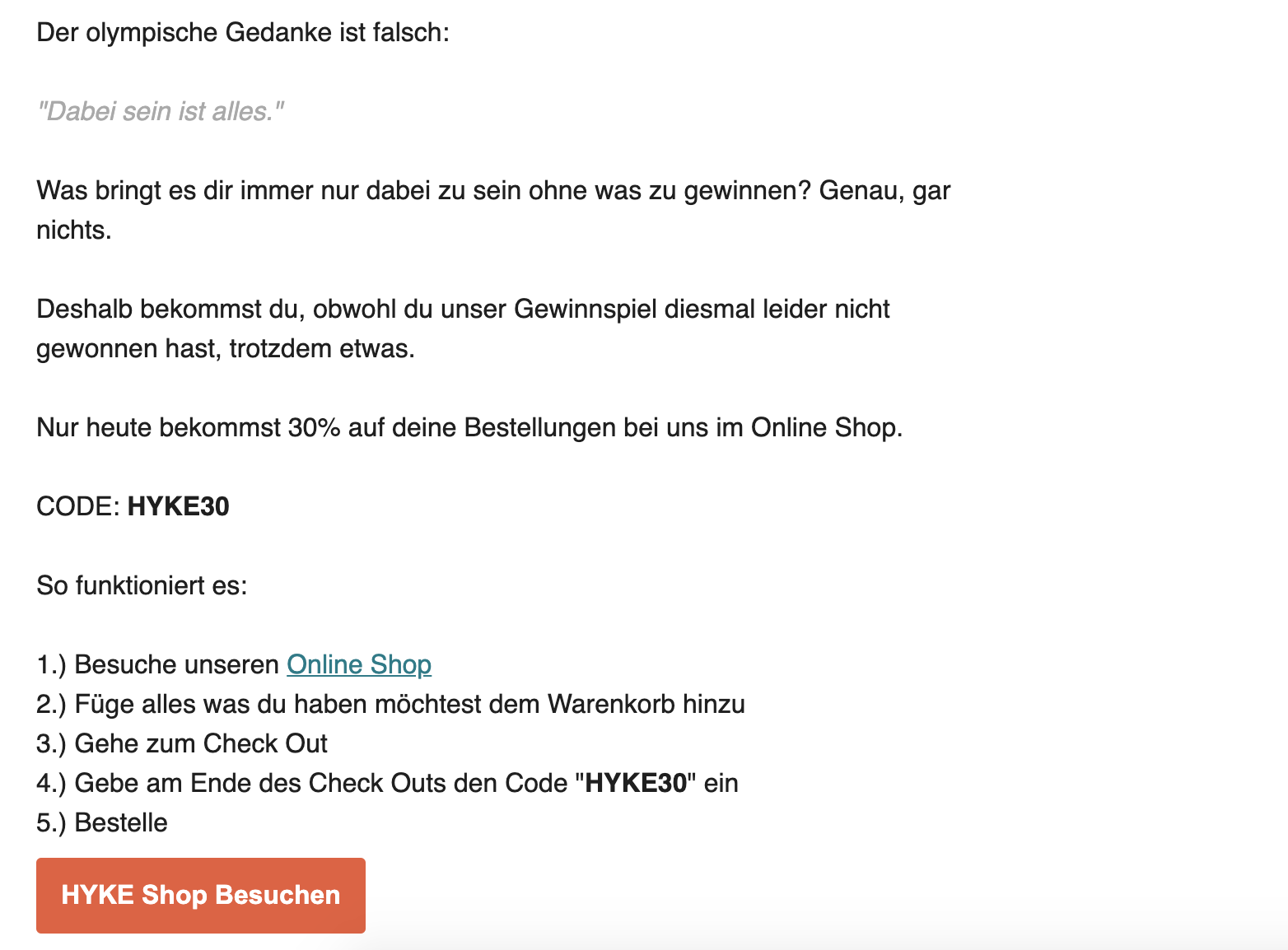
Translation:
“The Olympic thought is wrong:
“It’s not about winning, it’s about taking part.”
What’s good with just taking part but never winning? Right, nothing.
That’s why you’ll get something from us. Even though you didn’t win the giveaway this time.
Only today you’ll get 30% off on your orders at our online store.
Here’s how it works:
- Place your order”
- Enter the code “HYKE30” at the checkout
- Proceed to checkout
- Add all the products you want to your cart
- Visit our online store
88 people received that email.
It worked very well.
5 orders and €321.95 ($364 USD) in sales from that email.
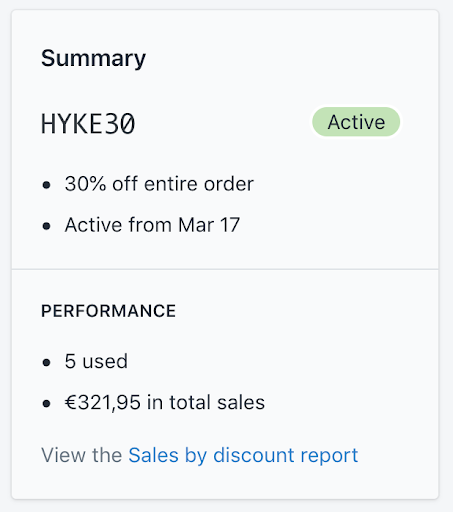
As we only promoted theHYKE30 discount code with this one email, we know that all the sales are coming from that one email.
A very good result for our giveaway. We will definitely try that again in the future.
The Final Sales Results
To make it short: we didn’t achieve the goal of making $1,000 in profit.
We sold:
- 8 backpacks for $730.00 in revenue.
- 3 snapbacks for $94.30 in revenue.
The sales came from:
- 5 backpacks and 3 snapbacks from running one giveaway.
- 3 backpacks from making 75 Instagram comments.
Overall, we did 11 product sales, and made $824.30 USD revenue.
To this day, we spent $2,523.73 USD to launch the business.
So we’re still at a loss of -$1,699.43.
Although we’re not a profitable business yet, and we didn’t achieve our 8-week goal, I don’t feel that we failed.
Here’s an overview from week #8 and my thoughts on the final result:
What’s Next For HYKE?
Fact is: people bought our products.
Somewhere in Germany people are wearing our brand. This alone makes me personally very happy and also proud.
Of course, being profitable is essential at some point, but the information we gained about our target audience (and us) is more important right now.
With me not being on military training now, it will definitely help the future of HYKE.
My partner and I will sit down, map out a new strategy based on all the data we have and continue to make sales.
So far I can think of three things we’d like to double down on:
- Content marketing (especially blogging)
- Influencer marketing
- Email marketing
But we’ll see what we actually end up focusing on.
And who knows… maybe we’ll expand overseas and you’ll see someone passing by wearing a HYKE backpack.
EDITOR’S NOTE
Tim didn’t hit the goal, but I think everyone can appreciate the realness of this case study. This wasn’t a “how I made $7.1 million dropshipping on Shopify while living in my Mom’s basement case study.”
This series was a peek inside what it’s really like to launch a business from scratch. You’re trying to juggle work commitments, spending time with your friends, and building a business you’ll be proud to work on for years to come.
Personally I’m interested to see if Tim can push through and hit his $1,000 profit goal. So I’d like to invite Tim back to do one last post on Sumo.
If you’d like to see how Tim makes his first $1,000 profit:
- Leave a comment of encouragement for Tim in the comments.
- Signup below and I’ll send you the step-by-step tactics Tim uses to make his first $1,000 in profit (once he hits the goal).
Yes! Send Me An Email When Tim Makes $1,000 Profit

Chris Von Wilpert
Sumo Director of Content
Add A Comment
VIEW THE COMMENTS